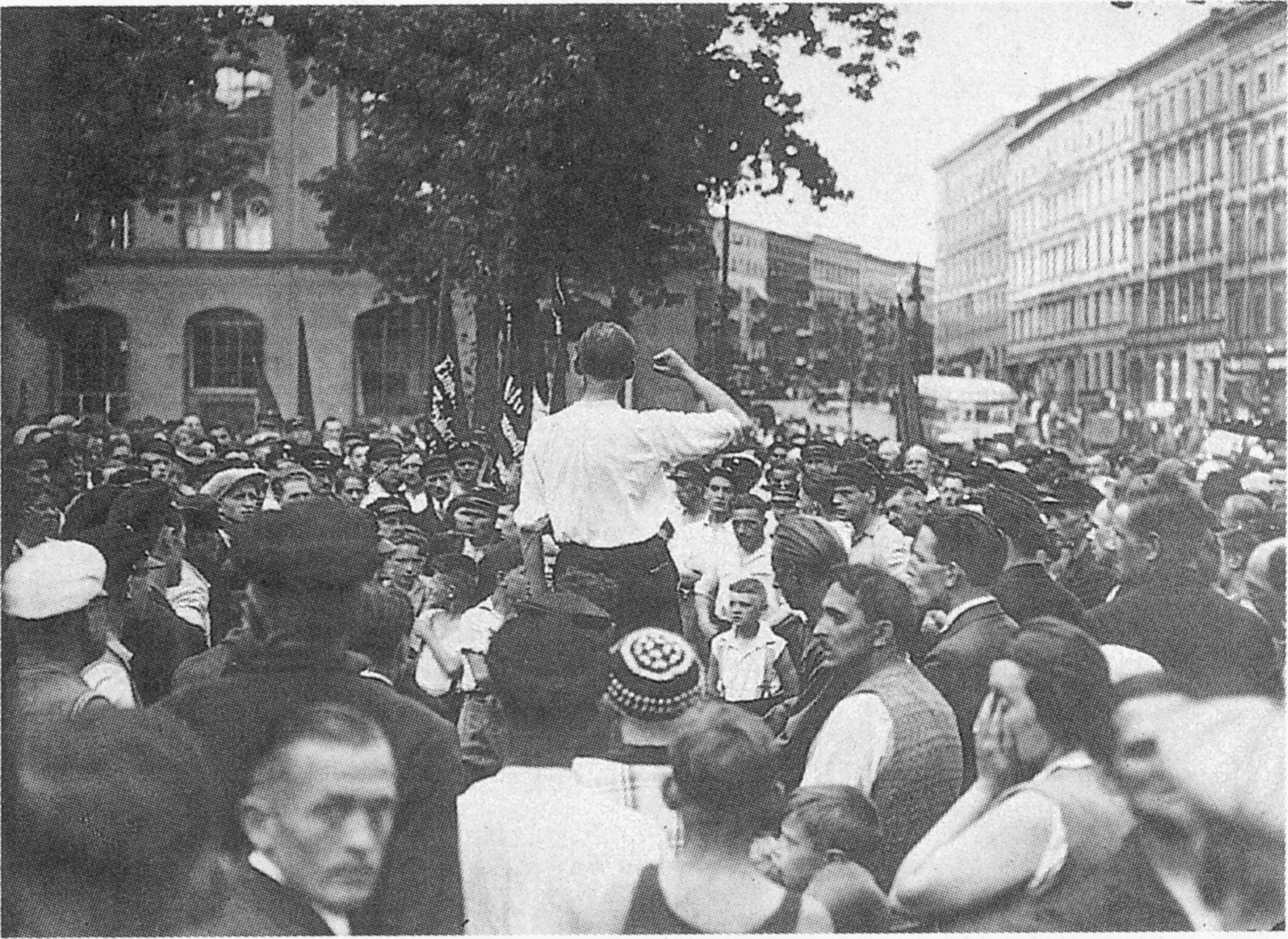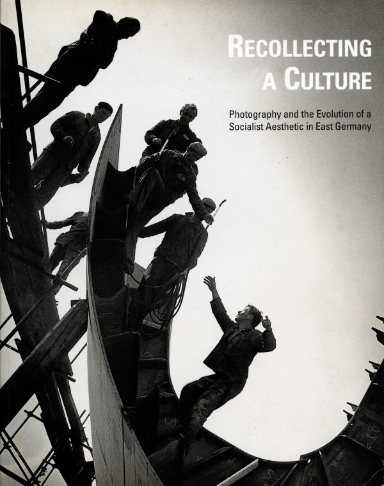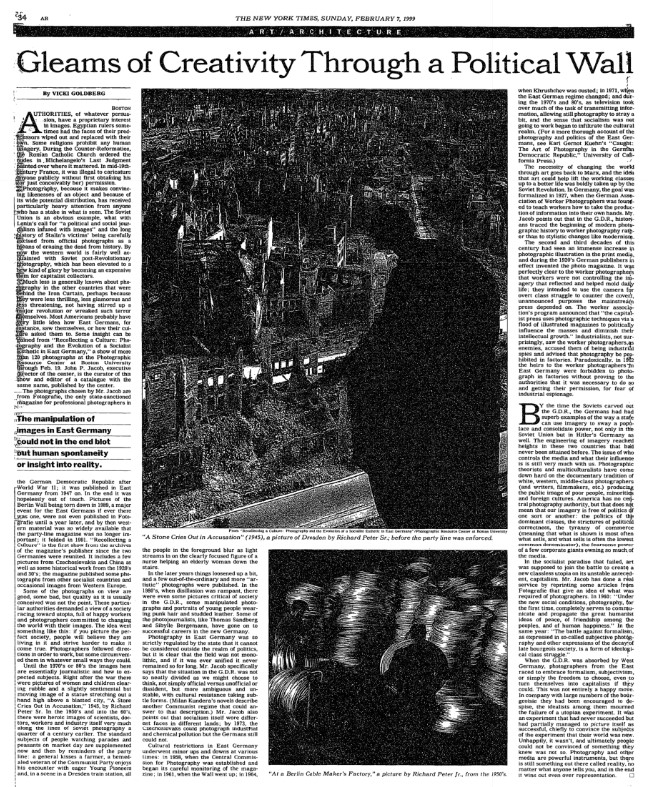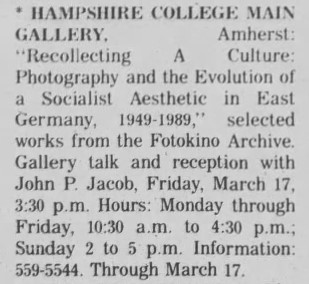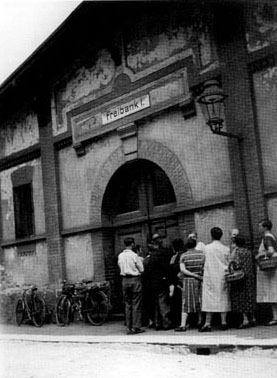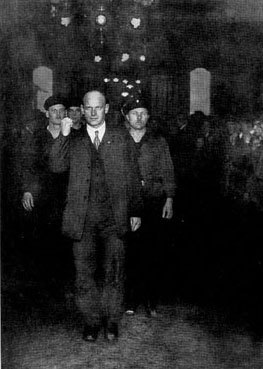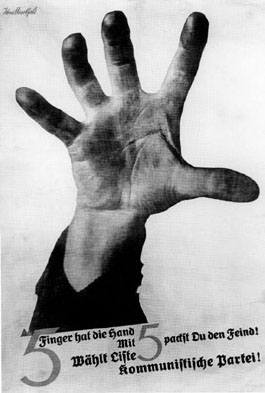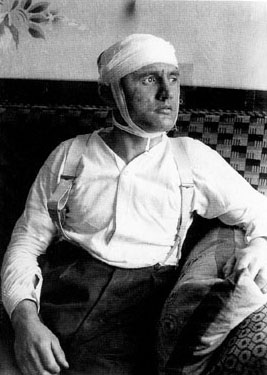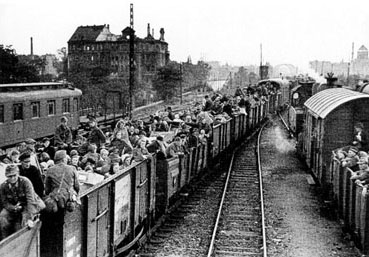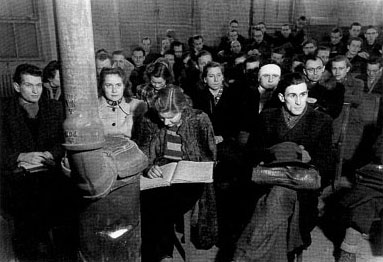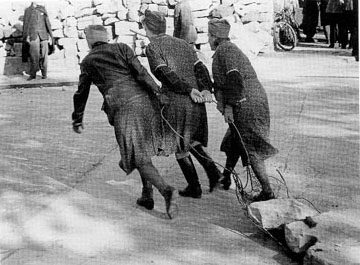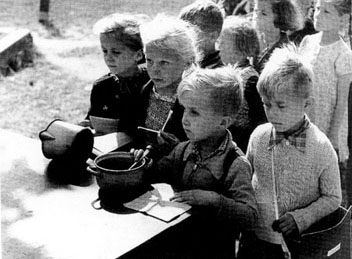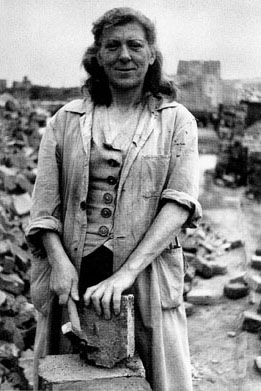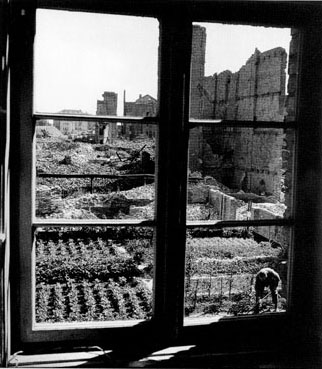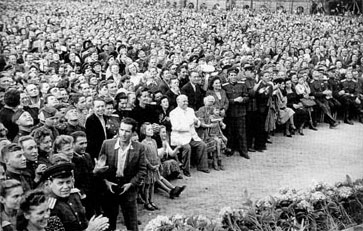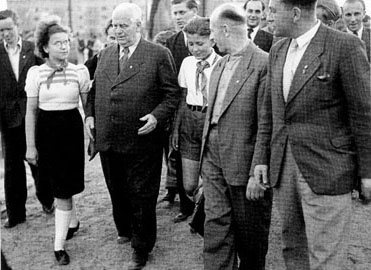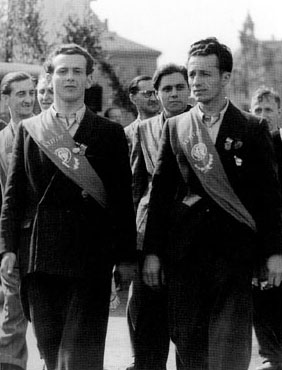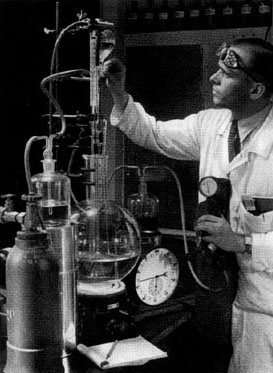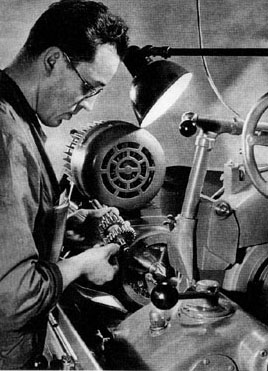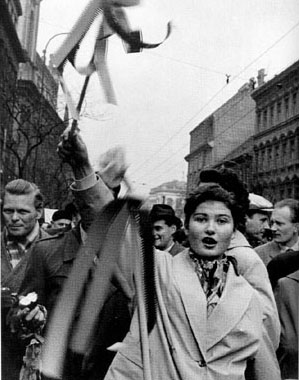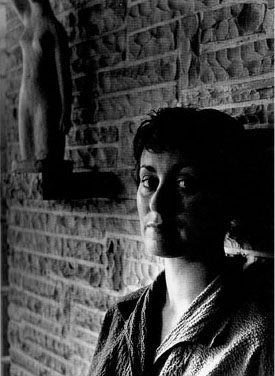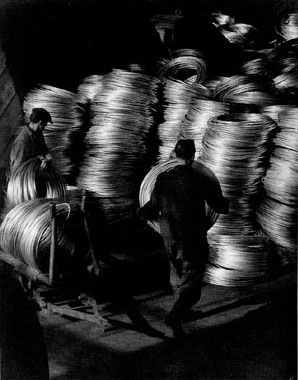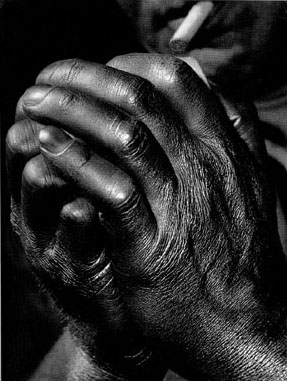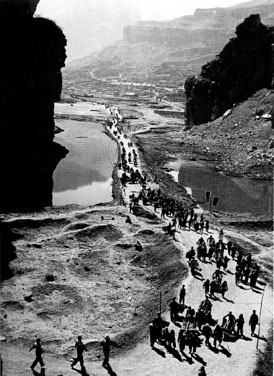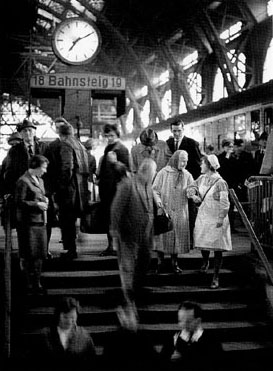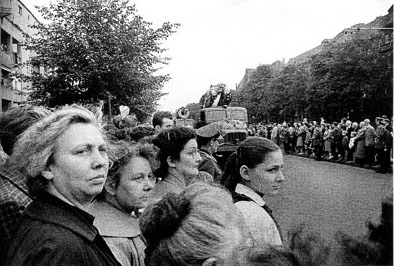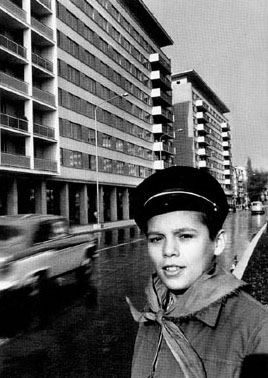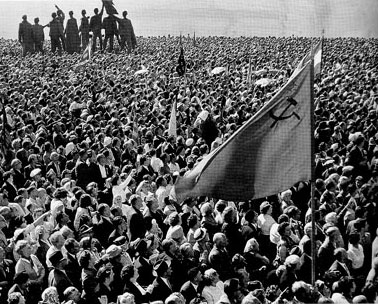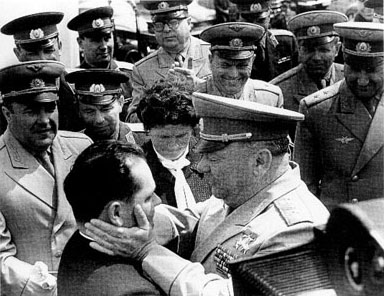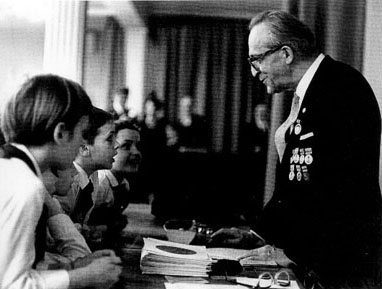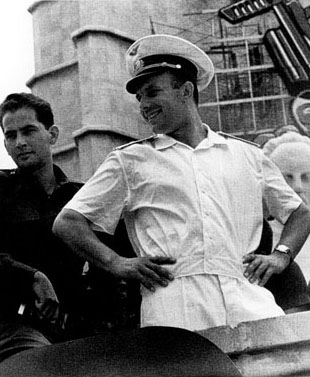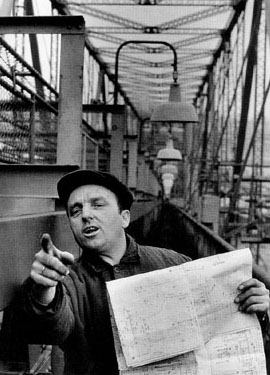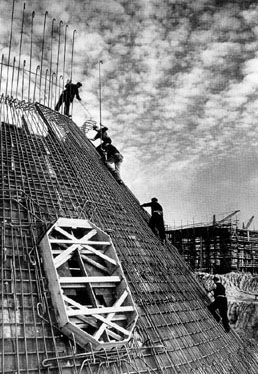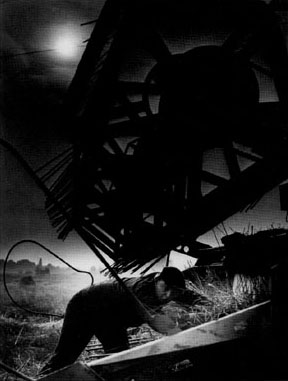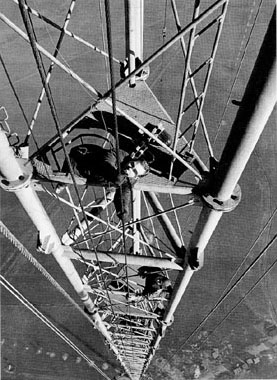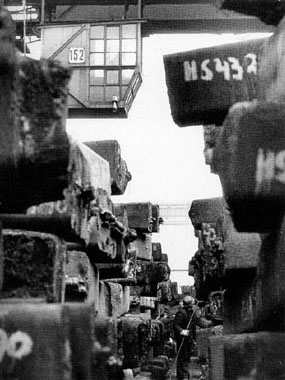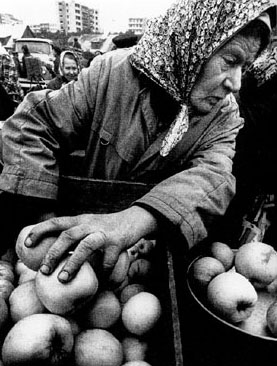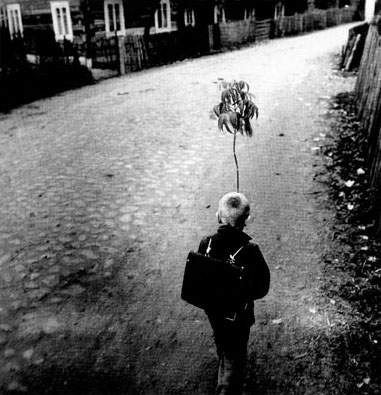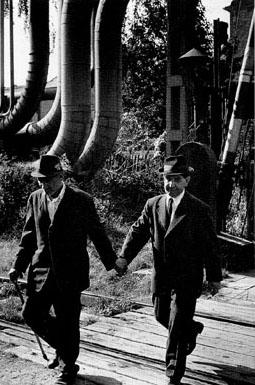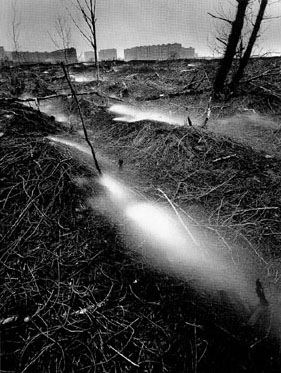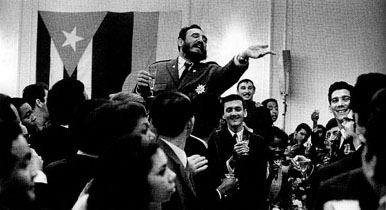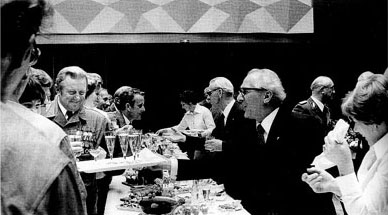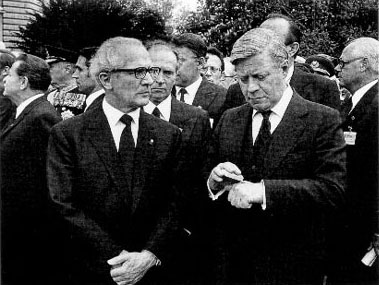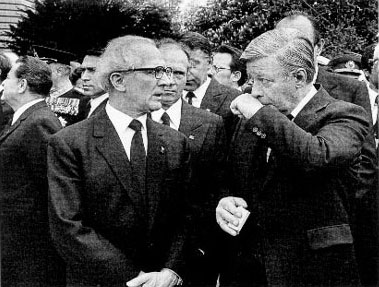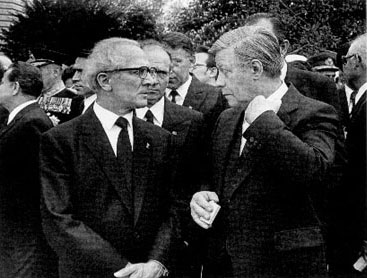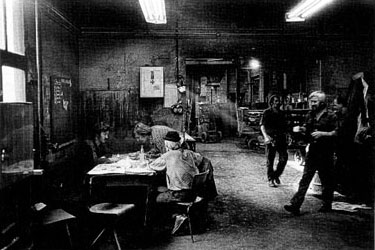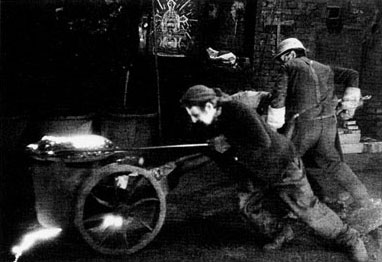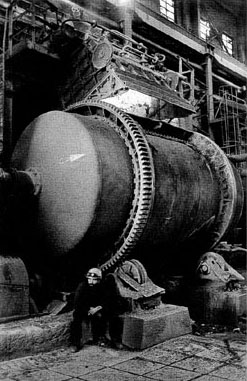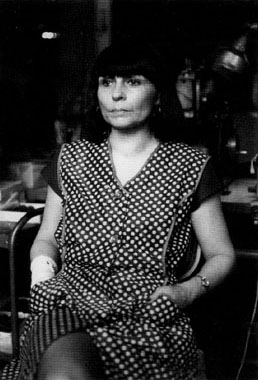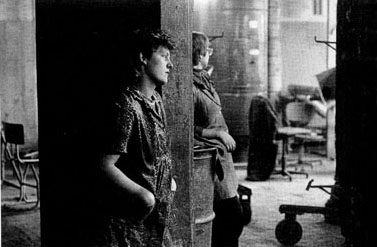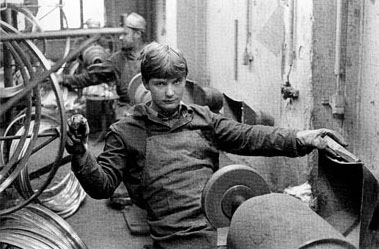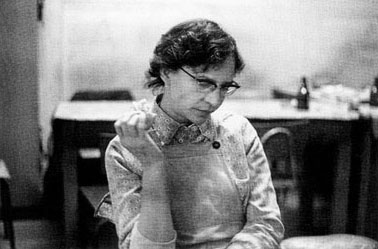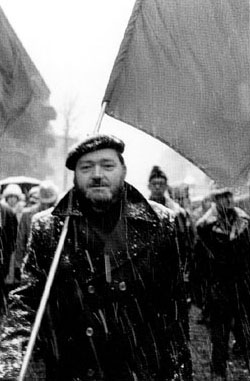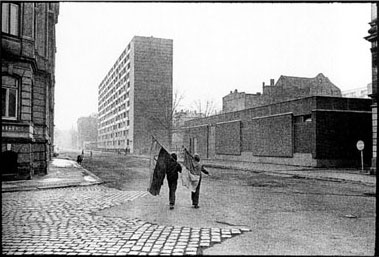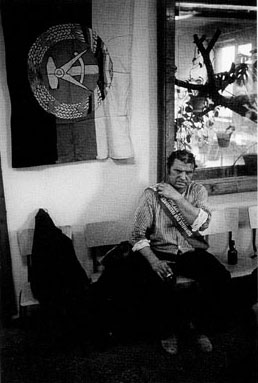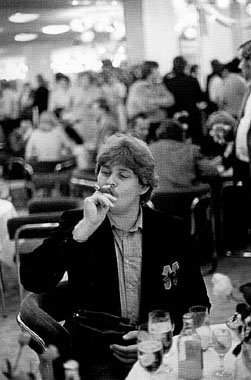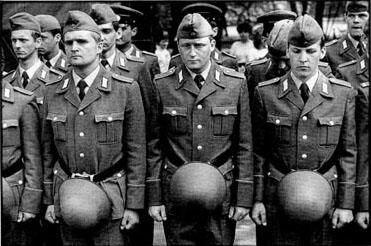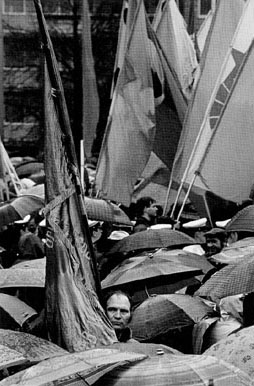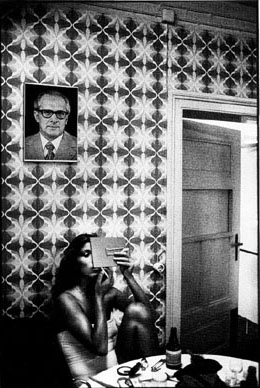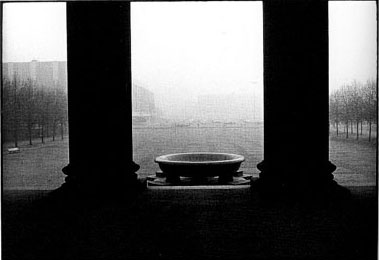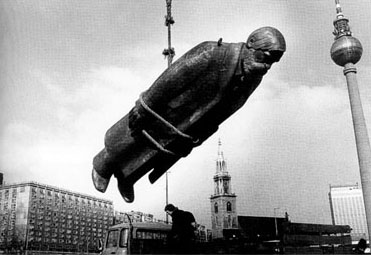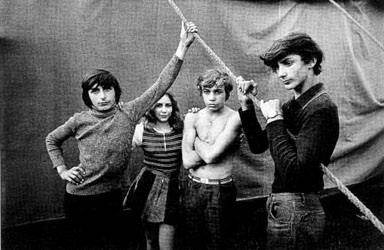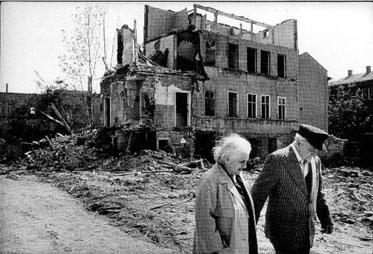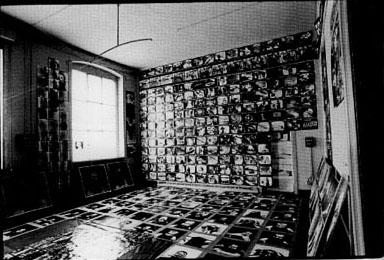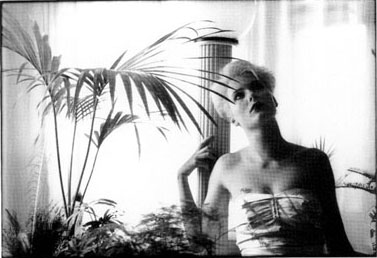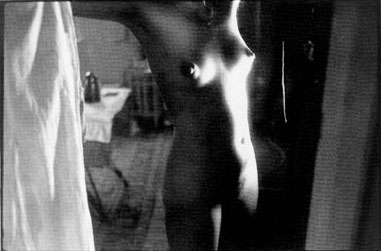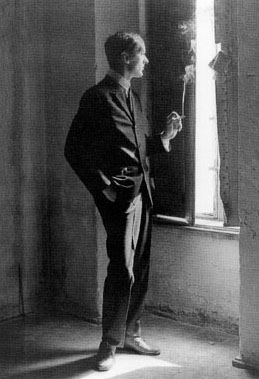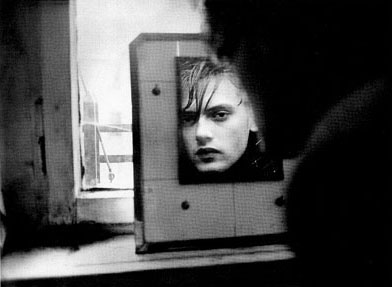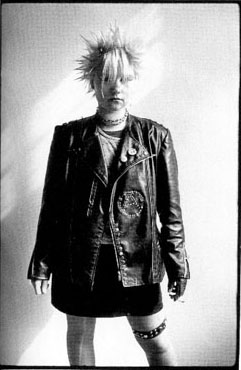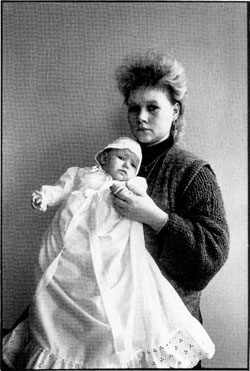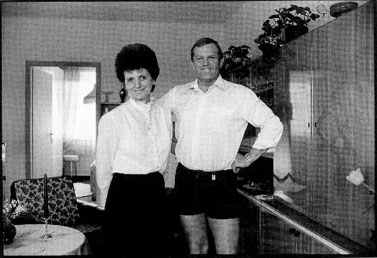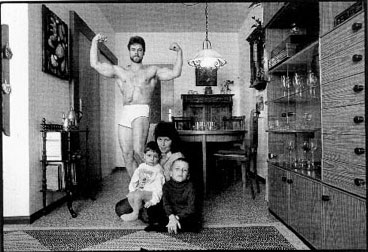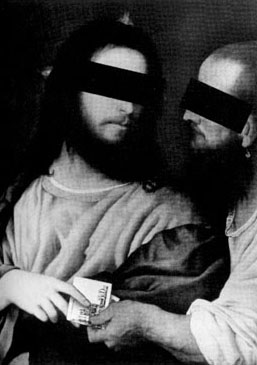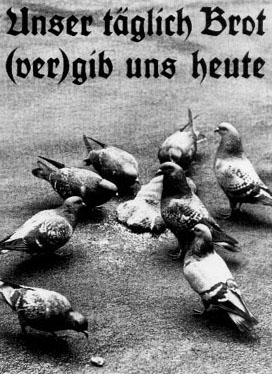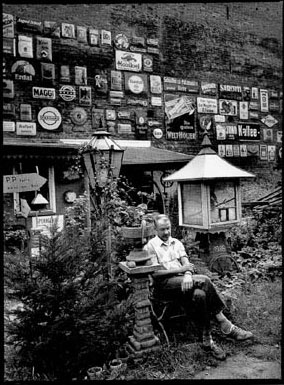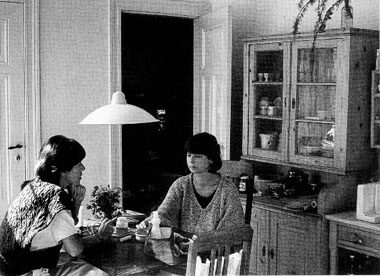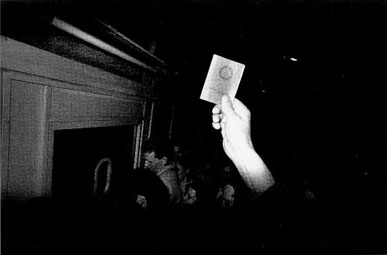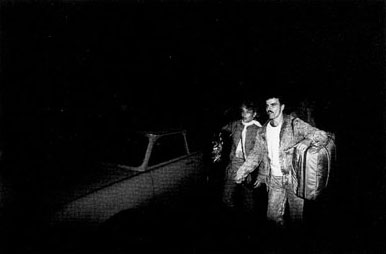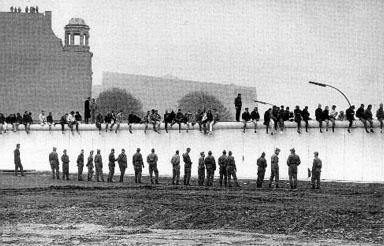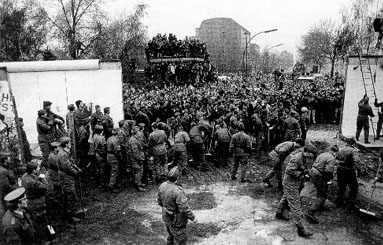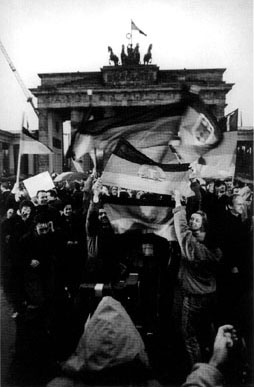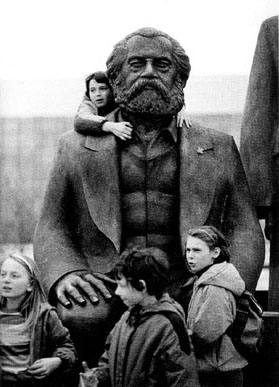The development of a socialist conception of art photography in the German Democratic Republic must be seen in the larger context of the formation of a socialist photo-art in Germany. Its beginnings go back to the workers’ photography and its struggle against fascism and militarism. -- Gerhard Henniger, Die Fotografie, 1966
Introduction
John P. Jacob, Boston 1998
Recollecting a Culture is a study of the political and economic pressures on the visual arts of the German Democratic Republic (GDR). It draws from the Fotokino Archive, comprised of approximately 14,000 prints and several thousand negatives, which was accessioned by the Staatliche Galerie Moritzburg Halle from the publisher V.E.B. Knapp, Leipzig, in 1989. Knapp began publication of the monthly periodical Die Fotografie in 1860. After the Second World War, along with all other media industries in the Soviet sector, Knapp fell under the control of the East German state. Publication of Die Fotografie was resumed in 1947. In 1964, the publishing house was moved to the nearby city of Halle (Saale) and its name changed to the Fotokinoverlag. Of the two periodicals published by the Fotokinoverlag between 1947 and 1991, Fotokino represented the interests of East German amateurs and photographic societies, while Die Fotografie presented professional and art photography from East Germany and abroad. In 1991, following the collapse of the East German economic and political structure, the Fotokinoverlag was closed.
As an instrument of East German socialism, Die Fotografie proposed a provocative revision to the history of photography. “The development of a socialist conception of art photography in the German Democratic Republic…” Gerhard Henniger wrote in 1966, “must be seen in the larger context of the formation of a socialist photo-art in Germany. Its beginnings go back to the workers’ photography and its struggle against fascism and militarism… Only in this way can one adequately judge the national and historical significance of our daily activities.” (DF 1/66, p. 8) Thus, in contrast to Western histories built upon a foundation of works by modernist and early-modernist masters, the history of East German photography was built from a body of images by amateurs and artists, largely unknown outside Eastern Europe and the former Soviet Union, whose photographs depicted the world from the class perspective of the worker. The works published in Die Fotografie and archived by the Fotokinoverlag were valued for their cultural and political resonance, and for their affirmation of the “humanistic impulse” as photography’s most significant contribution to art.
The first phase of East German photography, beginning in the late 1940s and institutionalized with the establishment of the Central Commission for Photography (ZKF) in 1960, represents a deliberate severance from western traditions. The first generation of East German photographers, including many who had participated in the worker photography movement of the 1930s such as Walter Ballhause and Eugen Heilig, focused on documenting the construction of socialism in Germany and developing an iconography of the peasant and workers’ state. An heroic image of the worker was articulated by artists such as Paul Damm and Käte Basarke, and a distinct East German style emerged characterized by realism in form and narrative. Of particular importance were photographic depictions of key socialist “types” and moments, carefully posed to enhance their drama of purpose and clarity of meaning. “Socialist realism represents reality in its revolutionary development, in its most progressive appearances. From these appearances, it then chooses the most basic, typical, and characteristic,” Professor W.P. Jefanow, Secretary of the Union of Soviet Fine Artists, declared in an interview in Die Fotografie. “The main task of the artist is to render man and his life in all its variety.” (DF 12/53, p. 331)
Many East German photographers banded together in professional support groups in the late 1950s, including non-conformists like the Leipzig based Action Fotografie. In spite of the ZKF’s call to photographers “to serve to render our present and our life even more beautiful,” (DF 8/60, p. 292) the non-conformists insisted that life and truth were more complicated than the “smooth, happy pictures” of socialist realism (DF 11/56, p. 304). The detachment that these artists cultivated in the early years of the GDR undermined the visual uniformity of socialist culture in the media, and may have contributed to the editorial takeover of Die Fotografie by the ZKF in 1960. Throughout the 1960s and ’70s, both as independent artists and as faculty at the Hochschule für Grafik und Buchkunst in Leipzig, they quietly spread their dissatisfaction with socialist aesthetics to their students, building a foundation for the more directly confrontational images of later generations of photographers. While seeming to adhere to the Soviet standard of humanistic art, work from this period by artists such as Arno Fischer and Evelyn Richter is characterized by a studied ambivalence toward its subjects. The presence of non-conformists in the seemingly fixed field of photography, and their move toward a more objective vision, resulted in an ideological divide among photographers that grew increasingly profound with the passage of time.
The Fotokinoverlag’s massive archiving of images began during the 1960s, and functioned primarily to valorize and authenticate the ideological mandate of the ZKF. The archive was the heart of East Germany’s evolving socialist aesthetic, its history as well as its future, and an artist’s relationship to it defined his or her position in relation to socialist culture. The archive also provided the state with an apparatus for observation of an artist’s production over an extended period of time. By assuming the right to re-present images under changing circumstances (as Richard Peter, Sr.’s photographs of the aftermath of the Dresden firestorm were differently presented in various historical and artistic contexts, for example), Die Fotografie’s editors also assumed the power to alter the meaning of those images over time. Thus, the Fotokino Archive was not merely an accumulation of social knowledge about East Germany, but a powerful engine of socialist propaganda and control.
The ZKF exercised its authority during the 1960s and ’70s through its direction of Die Fotografie and the Fotokino Archive. Most photographers, wishing to stay employed in their chosen field, complied with Die Fotografie’s aesthetic agenda. Many, however, found ways to work around it. A photographer might present a critique of a foreign country, showing poverty in the USA or strikes in West Germany for example, but not of comparable problems in East German society. East German artists were also held up to a higher standard than their foreign colleagues. Chemical pollution and social isolation were safe subjects for Czech photographers as early as 1973. Nude photography by East German artists was characterized by its implicit statement of physical health, while nudes from Poland were technically experimental and frequently erotic. The policy of different standards for different artists contributed to the instability of socialist aesthetics, and to the growing division between photographers who served the goals of the state and those who sought a higher purpose for their art.
The fine line that some East German photographers straddled between conformity and personal self-expression was made possible by the relaxation of Soviet authority following the death of Joseph Stalin in 1953. During the ensuing thaw, the constitution of the GDR was revised by the state legislature to reflect the evolving identity of the growing nation. Socialist realism was revised to reflect both the growing independence of East German art from the Soviet mold and the awakening of East German artists to their own cultural history. Having apparently outgrown its close identification with Stalinist rigidity, East German socialist realism came to be theorized from two opposing points of view. One side argued that change itself was the fundamental characteristic of socialist realism, and that this transformative quality was the key to its endurance and social significance. The other side concluded that socialist realism lacked theoretical coherence. Socialist realism, they declared, had been degraded into a slogan or sign used by proponents of widely opposing ideologies but was meaningless in and of itself. For these artists, the absence of a theoretical substructure revealed the superficiality of socialist realism, and suggested the eventual collapse of the authority of the state in cultural affairs.
The fine line that some East German photographers straddled between conformity and personal self-expression was made possible by the relaxation of Soviet authority following the death of Joseph Stalin in 1953. During the ensuing thaw, the constitution of the GDR was revised by the state legislature to reflect the evolving identity of the growing nation. Socialist realism was revised to reflect both the growing independence of East German art from the Soviet mold and the awakening of East German artists to their own cultural history. Having apparently outgrown its close identification with Stalinist rigidity, East German socialist realism came to be theorized from two opposing points of view. One side argued that change itself was the fundamental characteristic of socialist realism, and that this transformative quality was the key to its endurance and social significance. The other side concluded that socialist realism lacked theoretical coherence. Socialist realism, they declared, had been degraded into a slogan or sign used by proponents of widely opposing ideologies but was meaningless in and of itself. For these artists, the absence of a theoretical substructure revealed the superficiality of socialist realism, and suggested the eventual collapse of the authority of the state in cultural affairs.
That several of East Germany’s best known photographers were never represented in Die Fotografie is the result of a political ban on their work. Artists who produced images too distant from the socialist definition of photography (Thomas Florscheutz, for example, who in 1987 won European Photography’s First Prize for Young Photographers and exhibited in West Germany, France, and the USA, but was unpublished in East Germany and exhibited there only in private galleries) were prohibited from its pages, and thus forced to find refuge for their work in underground galleries and foreign journals. Others were omitted from Recollecting a Culture when it was apparent that Die Fotografie’s editors had selected the weakest work of an otherwise powerful artist (Gundula Schulze, for example, whose controversial portraits and nudes drew thousands of visitors from throughout Germany to the tiny White Elephant Gallery in East Berlin in the mid 1980s, but who was represented in Die Fotografie by a series of academic landscapes).
The wholly unexpected publication of Peter Oehlmann’s photo-installation “Selbstbefragung” in 1983 spoke eloquently for the many artists who were prohibited from Die Fotografie. The installation, composed of dozens of nude and angst-filled self-portraits of the artist, on the walls and floor of the gallery, plus a wall of images photographed from television and objects hanging from strings, had the appearance of a “private” or illegal exhibition. Its publication was unprecedented, and acknowledged the existence of a community of artists that had, until that moment, worked in utter obscurity outside the system of state support. Nothing that followed it was ever quite as shocking. Nevertheless, publication of Oehlmann’s work appears to have opened the floodgates for the presentation of works by a new generation of young artists who flatly rejected socialist aesthetics, and focused instead on the formerly hidden details of East German life. Images of sexual ambiguity and forthright eroticism, punk culture, apathy in the workplace and despair at home, as well as photographs that mocked state prohibitions on photography, grew increasingly common in the late 1980s, and drew large audiences to the exhibitions in which they were presented. The last generation of East German photographers struggled uncompromisingly to reinvest the image-making process with truth-value. If their work proved unpublishable in East Germany, rather than allowing the state to reduce them to silence, as had many of their predecessors, they sent it elsewhere and suffered the consequences.
The photography of everyday life, showing the gradual collapse of personal, social, and political stability in East Germany, is the true subject of this book and exhibition. Nowhere is this collapse more evident than in the ever-changing editorial mandates, the diatribes against bourgeois photography, the infrequent bold excursions into uncharted ground, and the progressively critical images presented in Die Fotografie. And nowhere is the failure of its socialist aesthetic more evident than in Die Fotografie’s editorial refusal to acknowledge the fall of East Germany in 1989. Images of the dismantling of the Berlin Wall and the demonstrations that preceded it do not appear in the periodical until 1990, a full year or more after they occurred. In its failure to recognize this most spectacular event through the photography of everyday life, Die Fotografie lost its opportunity to stay relevant to East Germans living and working in a fundamentally altered world. The final issue of Die Fotografie was printed in March 1991.
A small sampling of articles, most written during the 1960s, is presented here more or less in their original format, as seen in the pages of Die Fotografie. All of these articles were written by representatives of the ZKF, and all were selected for the clarity of the imperatives they describe. However, it should be noted that in addition to such politically oriented texts Die Fotografie regularly published one-person portfolios, group portfolios (frequently by worker’s brigades, but more often than not describing a particular theme or issue), instructional articles on scientific and “leisure” photography (animals, nature, travel, etc.), articles by curators, letters to the editor (including a popular forum for readers to respond to images), and much more.
Die Fotografie was read internationally, in communist as well as capitalist nations. Moreover, although it focused on work that underwrote its aesthetic agenda, Die Fotografie regularly presented images by historical and contemporary photographers from throughout the world. The photographs presented in Recollecting a Culture, however, are limited to artists from East and West Germany, the USSR and its European satellites, China, and communist Southeast Asia. My hope was that by narrowing its scope, Recollecting a Culture would be made to illustrate that, within the context of a divided nation and an evolving socialist aesthetic, East German photography grew from a strain of Soviet socialist realism to a distinct critical practice, and that Die Fotografie played a crucial, if not always positive, role in that development.
To American eyes, the methods and subjects of East German photography may appear formulaic and cliched. Writing on behalf of the ZKF, in 1960 Gerhard Henniger listed the themes most worthy of pursuit by East German photographers as “[one’s] own practice within production, his life in the brigade, within the family, his holidays, his recreation, his sports […] socialist naming and marriages, brigade evenings and cooperative meetings.” (DF-8/60, p. 292) Yet what we regard as banalities, images of the ordinary, are captured here with complete conviction. In fact, what distinguishes so much of the work presented in Die Fotografie is its simultaneous rejection of style and embrace of issues, such as health, work, youth and age, and leisure, all pictured though the lens of cultural politics. While acknowledging the humanism of The Family of Man and the work of the Magnum cooperative, the theorists of socialist aesthetics rejected the decisive moment as a mere formalist novelty. The stylistic elements of “critical realism,” as such favored Western photography was called, could not disguise its basis in class values. “Despite all critique of bourgeois society, the bourgeois class point of view is not abandoned,” Dr. F. Herneck wrote in 1960. (DF 8/60, p. 308) Socialist realism, by contrast, with its roots in the workers struggle and its ideals in the collective vision, represented a higher artistic achievement.
These ideas take some getting used to, and are easy to dismiss with post-1989 hindsight. That Die Fotografie was an organ of the state, and its advocacy of socialist realism a tool of East German propaganda, is self-evident. But to state, as Karl Gernot Kuehn does in Caught: the Art of Photography in the German Democratic Republic, that the ZKF’s editorial control over Die Fotografie represented “the certain end of the magazine as an occasional platform for subtle defiance” (Kuehn, p. 57), is ahistorical, untrue, and unjust to the editors, writers, and photographers whose work for the periodical did take risks. Moreover, searching for evidence of defiance is an inappropriate method for judging the impact of Die Fotografie on East German culture. Rather, the ability to work around the editorial mandate of the ZKF, undermining the theorists of socialist aesthetics by surpassing their demand for realism, is the key to much East German photography. In the end, the most powerful defiance was expressed by artists who adhered to Die Fotografie’s most fundamental demand: that they “represent reality in its revolutionary development… render[ing] man and his life in all its variety.” (DF 12/53, p. 331)
Recollecting a Culture is the culmination of nearly two decades of work with photographers from the former Soviet Union and Eastern Europe. During that time, I have worked almost exclusively with artists operating at the fringe of so-called “official” socialist culture. From the start, the idea of official versus unofficial cultures fit neatly into my conception of how contemporary art must exist in relation to socialism, and had to be shot down regularly by artists, editors, curators, and other administrators whose work, when properly presented and understood, told a much more complicated story. In fact, cultural workers in Eastern Europe did not occupy a zone of such black and white clarity as the terms official and unofficial (dissident vs. compliant) describe. Rather, they worked within a context of utter instability. In East Germany especially, this instability was sustained by an extraordinary level of bureaucracy, which transformed the terror of observation and control into banalities of everyday life. By the late 1980s, East Germany had become the society that Guy Debord described when he wrote that “totalitarian bureaucratic society lives in a perpetual present in which everything that has happened earlier exists for it solely as a space accessible to its police.” (Debord 1967, p. 75)
In no other circumstance have I ever seen the demand for truth so completely at odds with its result as in the art of East Germany. Recognizing this inherent contradiction, in the 1980s, East German photographers joined with artists, journalists, writers, and others throughout Eastern Europe and the Soviet Union seeking to redefine their cultures in their own terms. Whether traditional or experimental in approach, the goals of the last generation of East German artists were consistent with the goals of the first: to truthfully and realistically portray the socialist transformation of the German Democratic Republic. That they accomplished their goal, and in so doing contributed significantly to the transformation of late 20th century Europe, is a testament to the continuing power of photography to inform, to challenge, and to inspire.
Recollecting a Culture: Photography and the Evolution of a Socialist Aesthetic in East Germany
An exhibition of the Photographic Resource Center at Boston University, January 8 – February 19, 1999
Introduction
John P. Jacob
Acknowledgements
John P. Jacob
Photographs
Die Fotografie – An Interview with the Editor
T.O. Immisch and Gerhard Ihrke
Articles
Author Uncredited
Industry, its people – and the photographer. Die Fotografie 4/1948
Wolfgang Hütt
Photography of the Proletariat: A note on files and documents concerning the history of worker photography. Die Fotografie 8/1960
Gerhard Henninger
Path and Goal of Amateur Photography in the GDR. Die Fotografie 8/1960
Dr. F. Herneck
Concerning the Question of Socialist Realism in Photography. Die Fotografie 8/1960
Gerhard Henninger
Problems of Socialist Realist Photographic Art. Die Fotografie 11/1960
Rudolf Wedler
Photography Prohibitions (or: unlawful photography). Die Fotografie 3/1962
Gerhard Henninger
Concerning the significance of the traditions of German Workers’ Photography. Die Fotografie 1/1966
Walter Ulbricht
Words on Photography. Die Fotografie 8/1968
Booklists
Books of the Fotokinoverlag with/about GDR-Photography
Other important books about GDR-Photography (Selection)
Exhibition Rental
Postscript
John P. Jacob
Acknowledgements
In 1987, during a visit to East Berlin, my friend Karla Sachse gave me a book, one of the final publications pf the Fotokinoverlag, titled Fotografie in der DDR. At the time, it seemed to me an abysmal collection of photographic cliches. Yet many of those photographs appear in Recollecting a Culture. What has changed between then and now?
Almost everything. But the photographs have remained the same: traces of a world so utterly foreign that I might never have been drawn into it without the encouragement of many who lived there, and the support of others who did not. Rimma and Valeriy Gerlovin gave me both the courage and the contacts that I needed to start with. Andrea and Tibor Várnagy, Maria and Milan Knízák, Anna Bohdziewicz and Janusz Lipinski, Theo and Maria Immisch, and Karla Sachse and Joseph Huber, provided care and conversation that has deeply inspired and changed me over the years. I am indebted to many friends and colleagues for sharing their homes and the fruits of their learning, including Tony Dufek, Klaus Elle, Monika Faber, Thomas Florscheutz, Steffan and Martina Giersch, Marek Grygiel, Marek Gardulski, Volker Hamann, István Halas, Stephen and Brigitte Jacob, Lech Lachowicz, Andreas Leupold, Matthias Leupold, Lugosi Lugo and Aljona Frankl, Vaclav Macek, Thomas Ruller, Piotr Rypson, Tatiana Salzirn, Jurgen Schöberl, Aleksey Shulgin, and Zsuzsi Ujj.
Between 1986 and 1991, my work in Central Europe and Russia was made possible by a series of generous travel grants from the Soros Foundation, New York. My early work on East German Photography, and a first version of the essay that accompanies this catalogue, were presented at the College Art Association national conference in 1993, in a panel moderated by Vicki Goldberg. More recently work on Recollecting a Culture was supported by a generous Creation and Presentation grant from the National Endowment for the Arts (NEA), and by funding from the Goethe Institute, Boston.
The exhibition and accompanying publication of Recollecting a Culture were made possible through the cooperation of the Staatliche Galerie Moritzburg Halle. I am especially grateful to Dr. Peter Romanus, Director, and Theo Immisch, Curator of Photographic Collections, for their commitment to this project. Thanks are also due to the staff of the Photography Collection for their contributions. In particular, Gerhard Ihrke, Curator of the Fotokino Archive, patiently fulfilled all of my requests for material and information. I’m also grateful to Klaus E. Göltz for the design of this book, and to Christine Mehring for the translations of the texts that accompany it.
Recollecting a Culture is an exhibition of the Photographic Resource Center (PRC) at Boston University, which receives support for its programs from the NEA, the Massachusetts Cultural Council, the generosity of its board of directors and its members, and other private and public donors. Over the last three years, PRC staff members Sara Rosenfeld Dassel and Lizzie Fischbein, and former staff members Erica Kessel and Robert Seydel, have contributed significantly to the development of Recollecting a Culture. I am grateful to them, and to all the individuals and institutions who have supported this project over the nearly ten year period that it has evolved.
My greatest debt, for all that I have done and more than words can say, is to my family, Deborah Chapman and Acadia Jacob. Thank you.
John P. Jacob
Photographic Resource Center at Boston University
© 1989 by Photographic Resource Center at Boston University, authors and photographers
Recollecting a Culture: Photography and the Evolution of a Socialist Aesthetic in East Germany
An exhibition of the Photographic Resource Center at Boston University, January 8 – February 19, 1999
Introduction
John P. Jacob
Acknowledgements
John P. Jacob
Photographs
Die Fotografie – An Interview with the Editor
T.O. Immisch and Gerhard Ihrke
Articles
Author Uncredited
Industry, its people – and the photographer. Die Fotografie 4/1948
Wolfgang Hütt
Photography of the Proletariat: A note on files and documents concerning the history of worker photography. Die Fotografie 8/1960
Gerhard Henninger
Path and Goal of Amateur Photography in the GDR. Die Fotografie 8/1960
Dr. F. Herneck
Concerning the Question of Socialist Realism in Photography. Die Fotografie 8/1960
Gerhard Henninger
Problems of Socialist Realist Photographic Art. Die Fotografie 11/1960
Rudolf Wedler
Photography Prohibitions (or: unlawful photography). Die Fotografie 3/1962
Gerhard Henninger
Concerning the significance of the traditions of German Workers’ Photography. Die Fotografie 1/1966
Walter Ulbricht
Words on Photography. Die Fotografie 8/1968
Booklists
Books of the Fotokinoverlag with/about GDR-Photography
Other important books about GDR-Photography (Selection)
Exhibition Rental
Postscript
John P. Jacob
Photographs
Recollecting a Culture: Photography and the Evolution of a Socialist Aesthetic in East Germany
An exhibition of the Photographic Resource Center at Boston University, January 8 – February 19, 1999
Photographers:
Carla Arnold
Walter Ballhause
Tina Bara
Käte Basarke
Sibylle Bergemann
Volkmar Billeb
Helmut Broschk
Paul Damm
Walter Dreizner
Jochen Ehmke
Christiane Eisler
Arno Fischer
Christina Glanz
Konstanze Göbel
Kurt H. Hartmann
John Heartfield
Eugen Heilig
Walter Heilig
Albert Hennig
Herbert Hensky
Matthias Hoch
Erich Höhne
Frantisek Hubásek (Czechoslovakia)
Joseph W. Huber
Max Ittenbach
Hanna Jähnig
Eberhard Klöppel
Peter Koard
Rudolf Koch
Viktor Kolar (Czechoslovakia)
Hans-Wulf Kunze
Burkhardt Lange
Bernd Lasdin
Peter Leske
Matthias Leupold
Joachim Liebe
Alexandras Macijauskas (Lithuania)
Ute Mahler
Karl Heinz Mai
Wolfgang A. Mallwitz
Sven Marquardt
Erich Meinhold
Florian Merkel
Heinz Müller
Dr. Gerhard Murza
Heinz Nitschmann
Peter Oehlmann
Helga Paris
Robert Paris
Richard Peter sr.
Richard Peter jr.
Hans Joachim Reiter
Evelyn Richter
Klaus Rose
Günter Rossenbach
Thomas Sandberg
Boris Saweljew (Russia)
Frank Schenke
Erasmus Schröter
Werner Schulze
Erich Schutt
Bernd-Horst Sefzik
Petr Sikula (Czechoslovakia)
Valentin Sobolew (Russia)
Gerhard Stegelin
Detlev Steinberg
Uwe Steinberg
Helfried Strauß
Horst Sturm
Antanas Sutkus (Lithuania)
Nina Swiridowa (Russia)
Wei Teh-chung (China)
Ernö Vadas (Hungary)
Ralf-Rainer Wasse
Karin Wieckhorst
Fritz Winkler
Katja Worch
Die Fotografie – An Interview with the Magazine’s Editor
T.O. Immisch, curator of the collection of photographs at the Staatliche Galerie Moritzburg Halle, which has housed the picture collection of the former Fotokino publishing house since 1992, asked the questions. Answers were given by Gerhard Ihrke, photographer, author, and editor, who from 1964 till 1991 was the editor of the publishing house’s two magazines, Die Fotografie and Fotokinomagazin. Now he is caretaker of the Fotokino collection at the museum.
How was this magazine re-established at Halle’s Knapp publishing company after the war?
By doing so, the Wilhelm Knapp publishing company continued a tradition. More than one hundred years before, in 1839, the first instruction on daguerreotyping in German had appeared in Halle. The Knapp publishing company published various photographic magazines, and so it was only logical that they also tackled the publication of a photo magazine after the war again, which happened under very difficult circumstances. The first issue of Die Fotografie appeared in July 1947 in the then Soviet-occupied zone. This issue’s subtitle named the previous seven different magazines, which referred to the various publications of pre-war times. It is therefore no wonder that the magazine was of nearly all-German character, as photographs and articles by authors from all over Germany were published in it. This did not change until the end of the 1950s. After 1961, publication of authors from the Federal Republic became a mere exception. However, this was mainly due to the fact that the publishing company and the editorial staff were lacking the foreign currency required to pay the fees. In 1952, the Wilhelm Knapp publishing company was transformed into a state-owned company. This firm name led to complications in the export of the magazine, and even more so with the books, into the Federal Republic; and therefore, they decided in 1957 to rename the »VEB Wilhelm-Knapp-Verlag« publishing company to »VEB Fotokino-Verlag«. Now, export to West Germany was possible again. It should be mentioned, however, that only a few issues of the magazine were delivered to the Federal Republic, whereas things were different with the technical photographic books, which were much sought-after even in the Federal Republic.
How did the magazine become an extension of the Central Commission of the Cultural Association of the German Democratic Republic?
The Central Photography Commission (ZKF) of the Cultural Association of the GDR was an umbrella organization for the photographic work in the GDR. It coordinated the photographic work in the country, organized photographic exhibitions and supported the social recognition of photography, which then – unlike in the USA – still represented a peripheral phenomenon in society, culture and art. Naturally, a magazine was needed for that, and therefore they ended up combining the Central Commission with the »Fotokinoverlag« publishing company. The Central Photography Commission became responsible for the editing of the Die Fotografie magazine.
What goals did the ZKF pursue with the magazine and how did they influence its contents and layout?
It has already been suggested what the ZKF was interested in, what has to be emphasized, however, is a statement that appeared in the December 1957 issue of the magazine and that actually expresses everything with regard of the aims being pursued at that time. It reads: »Photography is to be led out of a state of unconscious Weltanschauung and political neutrality in order to have it, being an activity in accordance with party thought, consciously embrace the building of GDR socialism.« An advisory committee consisting of leading members of the ZKF presidency was charged with monitoring the editorial staff. This advisory committee was informed of everything that was to be published, and later they evaluated the published magazines. Some articles and photo publications were frequently criticized, and this went on until the end of the 1960s.
What were the effects of the politico-cultural »breaks« – for example in 1965, after the 11th Plenum* or in 1971, after the change from Ulbricht to Honecker?
I guess that after 1971 a certain tolerance emerged or started to become apparent. This had an effect also on the work of the editorial staff, as in some respects they could tackle problems of photography, regarding contents, in a more liberal way and publish more differentiated photographic conceptions. What I mean is, it was no longer so much the point to publish representations that were to be classified as »socialist realism« as it is called. Now, the advisory committee was more open-minded about many subjective photographic ideas.
Were there times of greater or lesser independence of the editorial staff?
In spite of the supervision of the ZKF, the editors were comparatively independent. They chose the subject matter, determined the make-up of the magazine, and emphasized the main points regarding content. After the issues were published, the advisory committee discussed the magazine. This was normally done every six months. In a sense, the editorial staff did work independently. There was a good cooperative relationship between the advisory committee of the ZKF and the editors. Naturally, the projects and plans of the ZKF and the later Photographic Society (GfF) were supported and promoted by publications. For example, editors were represented in juries of photo shows, they were involved in the development of large-scale exhibitions, and so, at an early stage got some sort of an idea of the pictures to be selected for the magazine and of potential themes. It was important that the editorial staff be informed early because they had to prepare each issue four months in advance of printing. Can you imagine, how they wished to be topical?
Was it a problem to meet the double demand of making a magazine for both professionals and amateurs?
Yes and no. As the ZKF and the later GfF were organizations that felt bound to both professional and amateur photography, as editorial staff, we had to take into consideration works from these fields as well. In many cases, use was made of articles on exhibitions, exhibition evaluations, reviews, contributions on renowned photographers, well-working and efficient photo groups and clubs, and so it actually wasn’t too difficult to bring these works from different fields together. Of course, discontinuities in quality happened. Discontinuities also happened because of one characteristic printing feature: First forme and second forme printing reproduction of color pictures was possible to a very limited extent only. Therefore, the position of those color pages often determined the length of contributions. As color photography at that time couldn’t keep pace with black-and-white photography, again, discontinuities were the result. Looking upon them today, absolutely embarrassing ones, in some cases.
For years, the »Fotografie« magazine had been printed in letterpress printing. Why did the publishing company change to intaglio printing in the 80s?
The magazine was among the few that were now and then granted an increase in circulation in spite of the paper shortage existing in the GDR. The publishing company couldn’t just simply increase the circulation off its own bat, but it was the state authorities who decided on a larger paper allotment and with that on a higher circulation. In the 1980s, 50,000 issues of Die Fotografie were printed (and sold) in good quality. Further increases in circulation, however, wouldn’t have been anymore possible in letterpress printing, technically. From No 1/1981 the magazine appeared in intaglio printing. To that the editorial staff had pinned high hopes, as intaglio printing, after all, is a fantastic technique for reproducing photographs in all their subtle gradations. Unfortunately, the printers didn’t always succeed in meeting those expectations. That had mainly something to do with the paper quality, but nevertheless, intaglio printing was very well received by the community of photographers in this country.
Why was publication of the magazine stopped and the publishing company closed down?
At the time when the Wall came down, in 1989, the magazine had a circulation of approximately 75,000. Now, however, that the press publications of the Federal Republic were glutting the local market and people had to make up for lost time, it is quite obvious that the circulation of all of the »Eastern« magazines crashed. The newsstands were flooded with the colorful pictures of the magazines from the Federal Republic. The publications of the »East« were lying around somewhere at the back and were hardly in demand anymore. It took some time until this leveled off and the demand of those concerned was satisfied. They noticed that the others were not different from anybody else. In the middle of 1990 the circulation of Die Fotografie leveled out at 16,000 sold issues, which just absolutely corresponded to the demand in the ancient GDR. It is therefore no wonder, that the publishing company gradually got into financial difficulties and the printers refused to continue working on the magazine. So the April 1991 issue had to be withdrawn from the printing house. The March 1991 issue was the last issue of Die Fotografie magazine. It was only after the magazine had disappeared from the market that they noticed, and this was the case with other local press publications as well, that now something was missing. Revival, however, was not possible. The publishing company was taken over by the trust company and finally sold. The new owner was not interested in the »Fotokino« literature. In June 1992, a 150 year old publishing tradition came to an end.
How do you judge today the importance, role, and function of the magazine – what did it achieve and what did it not achieve?
I’m afraid it’s not easy for me to answer this, naturally, because I had been working for more than 25 years with that editorial staff. Over all those years we really tried hard to deliver a very true reflection of the development of photography in the GDR. We tried not to miss any of its facets and to take any sphere into consideration. I guess, on closer examination, those years’ issues deliver a vivid reflection of photography in the GDR. By presenting exemplary works of renowned photographers from at home and abroad, especially from the socialist countries, reporting on their working methods and acknowledging their work, we were able to present examples which did have an effect. In the wider sense, Die Fotografie was a kind of picture book, and this was something that did partly make up its popularity, as otherwise they wouldn’t have been able to sell a circulation of that size at the newsstands in our little country.
Do you see any magazine in the German-speaking world at present, which is similar or comes close to »Fotografie« as far as standard and program is concerned?
This question isn’t so easy for me to answer either. People who live (or better used to live) in glass houses shouldn’t throw stones. I’m afraid, a magazine like Die Fotografie with its message and design in those days wouldn’t be possible anymore today. Our unspoken shining example was the Swiss magazine Camera. Due to tightened conditions, it had already disappeared from the market in 1981. As I see it, there isn’t anything comparable anymore among the German-speaking magazines.
* The 11th Plenum of the Central Commity of the Socialist Unity Party, with which a very restrictive phase in the East German cultural policy began.
Recollecting a Culture: Photography and the Evolution of a Socialist Aesthetic in East Germany
An exhibition of the Photographic Resource Center at Boston University, January 8 – February 19, 1999
Introduction
John P. Jacob
Acknowledgements
John P. Jacob
Photographs
Die Fotografie – An Interview with the Editor
T.O. Immisch and Gerhard Ihrke
Articles
Author Uncredited
Industry, its people – and the photographer. Die Fotografie 4/1948
Wolfgang Hütt
Photography of the Proletariat: A note on files and documents concerning the history of worker photography. Die Fotografie 8/1960
Gerhard Henninger
Path and Goal of Amateur Photography in the GDR. Die Fotografie 8/1960
Dr. F. Herneck
Concerning the Question of Socialist Realism in Photography. Die Fotografie 8/1960
Gerhard Henninger
Problems of Socialist Realist Photographic Art. Die Fotografie 11/1960
Rudolf Wedler
Photography Prohibitions (or: unlawful photography). Die Fotografie 3/1962
Gerhard Henninger
Concerning the significance of the traditions of German Workers’ Photography. Die Fotografie 1/1966
Walter Ulbricht
Words on Photography. Die Fotografie 8/1968
Booklists
Books of the Fotokinoverlag with/about GDR-Photography
Other important books about GDR-Photography (Selection)
Exhibition Rental
Postscript
John P. Jacob
Industry, its people – and the photographer
Author Uncredited, Die Fotografie 4/1948
When hearing the term »industrial photography,« the layman frequently has a very specific understanding of it, an understanding which only incompletely and one-sidedly gets to the essential core of this important branch of photography. That is: He mainly sees steaming chimneys, giant workshops, conveyor systems, or, at most perhaps endless and loaded freight trains. In his mind (and he never thought about it), industrial photography is nothing but constantly new versions of the representation of these industrial symbols.
In addition, he usually allows these images to speak to him in some sort of romantic way, and not as merciless objective documents of civilization. Last but not least, this is the case because the photographs of these industrial symbols, which were meant for general viewing contexts (and hence for a large audience), had a more or less noticeable, romantic aura. Photographic exhibitions, cultural magazines, picture calendars, and photo-yearbooks showed this clearly – always under the condition that exceptions only confirm the rule.
Purely objective representations were reserved for specialists who had a specific interest and were part of their context.
Back to the layman and his very incomplete understanding of industrial photography. What does he know of the exceptional role that photography plays in and for the industry today? Yes, one is often confronted with the opinion that the industrial photographer is second-rate. He is so because he takes photographs only of lifeless objects. Furthermore, one often searches in vain for essential traits of the beautiful in these objects. By the least, these are undoubtedly objects whose national-economic usefulness has priority over any aesthetic considerations. From such a (one-sided) viewpoint, the practice of industrial photographers could appear profane in comparison to the creations of a portrait photographer. The work of the former then appears as the mere mechanical execution of an inevitable process.
Anyone who has only once experienced an industrial photographer intensely occupied with his task will change his mind very quickly! When he sees how an industrial photographer works with extensive sets of lamps in giant workshops and nevertheless has to struggle with insufficient lighting. When he sees him climbing high scaffoldings, dangerous to life, because the task required it! When he experiences how the industrial photographer has to give directions in workshops where he can hardly hear himself, and perhaps in temperatures, which the regular visitor would find unbearable! When he sees that the industrial photographer had to deal with the respective weather conditions because certain photographs had to be taken under any circumstances! When he has witnessed that the industrial photographer had to put on leather uniforms to go along down into the pits to take photographs in positions completely unknown to the studio photographer! When he sees him not bothered by dust, flue ash, or oil stains, when he sees him disappearing into a still very hot, damaged boiler and returning as if coming out of a steam bath! When he witnessed in person that a task frequently requires use of a large camera, although the exclusive use of a small camera is so tempting because it involves so much less physical strain – while then of course in practice the results would be less »tempting« than the large format photograph. These are some flashes onto the practice of the industrial photographer, who has truly earned his name. And maybe another nerve wrecking circumstance should be mentioned.
The assignment for the industry may require that in order to solve a specific problem, the production is stopped for some few minutes (everything to the smallest detail must be prepared). For the production, »some few minutes« can imply: expenses that go into the hundreds. Nothing must go wrong here. A single mistake has completely different consequences than a studio photographer telling his client »Please come again, the plate had a problem,« or »You moved!« Where the minutes are counted in hundreds, the industrial photographer cannot come up with petty excuses!
Let’s draw a comparison between the portrait photographer and the industrial photographer regarded as second-rate.
(We consciously do not figure into our comparison the truly grand photographers, those of first caliber who represent man. Their achievements are on a completely different level.)
The studio photographer moves a few curtains or turns on his lamps to be independent from exterior lighting condition. The model is »posed!« What counts here is, to a large extent, not the natural pose and movement, but simply how »interesting« the pose is! For if they spend the money, the majority of clients wants to see themselves not life-like, but interesting at all costs. The lighting choice is dependent on this too. The necessary schemes can easily be found in celebrity picture-postcards. And if one has practiced these things hundreds of times, it works without effort. Then comes the well-known »click« of the trigger. And since one has executed the same thing under the same light conditions for years, a (technically) reasonable negative simply must come about. Nothing can really go wrong. And from the [studio] showcases, uniform schemes then look out at the contemplative viewer. He may now be more inclined to recognize that the industrial photographer is not the only one occupied with the representation of »lifeless things (a fact which one likes to degrade him with)! And to be fair, then compare the mere photo-technical difficulties of the industrial photographer with the smooth working process of the portrait photographer:
The latter takes photographs always under the same conditions. The industry specialist simply always has to cope with new contexts: changes in natural light caused by well-known, inevitable factors; daylight mixed with artificial light; or – because nothing else remains – vacu-flashlights or open flashlights, whose effect can never be calculated ahead of time, especially not in giant, more or less dark halls.
Or: Black machines with shiny and mirroring parts against large windows hit by the sun. It borders on mental acrobatics and is often not less dangerous than artistic acrobatics to deal with such conditions in the context of simple photographic technology.
Furthermore, close-ups true to the material require an extraordinary technical skill on the part of the industrial photographer. Moreover: Emphatic aesthetic considerations play a role as well since many industrial photographs are not only used for production purposes but should also have an advertising dimension. All this is usually overlooked when speaking of a »mere« industrial photographer.
Added are the already mentioned physical strains. Who would doubt under such conditions that a successful industrial photographer must probably master his craft (in the broadest sense) in a completely different way than a portrait photographer, who likes to think of himself as an artist and for this very reason regards the industrial photographer (whom he does not deem an artist) as second-rate on the professional scale. This might also be the case because the industrial specialist, like the workers, often cannot remain very clean when he works and takes photographs of dirty things. Dirt from work, however, can make someone lose prestige in the eyes of foolish people. From this point of view (to which one could easily add others) it follows clearly how out of place it is to call a human being, who carries the whole burden of his profession, a »mere« industrial photographer.
But can’t we think of a synthesis between pure portrait photographer and man of the industry? Most certainly! And this question touches on a point which publications on the topic of »industrial photography« have hardly even hinted at. This concerns the true and close-to-life image of the worker and any other craftsman.
Through his work, the industrial photographer is in constant contact with workers and craftsmen. Often he cannot even manage without their help. Why shouldn’t a few photographs be taken during the breaks, in private, not commissioned? After all it could be possible that a respectable collection of images accumulates. The smallest as well as the largest industries are rich mines for such discoveries. One can find wonderful character portraits everywhere. And the photographer does not even have to sneak up to them. They are just there! And the industrial photographer finds the worker and craftsman in a way that they would never enter the studio: in their working clothes – traces of work on their hands and faces. He encounters him at work, with a machine tool, an anvil, at the melting furnace, or maybe at the fermenting vat of a brewery. And find a worker who would turn down such an offer. But not just the photograph of the whole figure can be inspiring – on the contrary: Working in that direction would imply a general broad scope. Fascinating, however, are those photographs which show the worker in close relationship with »his« machine, the machine he has somehow grown together with. The law of »pars pro toto« (a part for the whole – or put even more precisely: an essential part weighs more than the insignificant whole) leads to entirely terse images that make a strong impression. This also results in interesting visual studies of work psychology. Yet under no circumstances should one just rush to shoot photographs – first one should observe, and then observe again. That can always be done with only a few glances. The image should first take shape in the photographer’s imagination, then he should begin to shoot. A moment which the camera caught too soon will often lack the necessary concentration in the image. It is not necessary to use a high-speed camera: Success stems not from the technology but from handicraft skills and psychological intuition.
The climax, however, is the full-image character portrait, captured with nuanced empathy. It is not difficult to imagine the effects of a portfolio of such photographs! The attempt to capture simple human beings in a systematic and grand way was already made once: This was Lersky’s book Man in Everyday Life. If this book did not have a great impact, this was the case because Lersky did not take the people as he found them: grand in their simplicity. Rather, he treated them like a moldable mass, made them will-less and then captured them in the way in which he wanted to see them.
For twelve years it has been sermonized that only the peasant can still have an unspoiled, expressive face – this sermon was methodical, we were flooded with images of peasants – we were served images of farmers on any suitable or unsuitable occasion. This ruthlessly calculated and sentimentally served spook is over. What remains is the insight that the huge army of craftsman and industrial workers probably includes a larger percentage of characteristic faces than these peasants!
It would be a nice private task of the industrial photographer to prove this viewpoint.
Don’t believe the peasant was so content with himself that he disliked any posing! On the contrary. The industrial photographer avoids this danger with his models when they see him as their working pal. In the event of a more distanced relationship to the models, it is only the art of treating humans that surely leads the industrial photographer to his goal.
Little needs to be said about technique. The industrial photographer, who has mastered other things, will hardly find it difficult to solve the technical problems of his portraits.
This is important: the background should either be part of the image, or it should be as restrained as possible – one can always find a plain wall. A good visual effect is destroyed by unfocused planes floating around in the background. The worst fear one might have, however, is contrast! One should not shy away from strong lights and crisp shadows – they work out the facial expression in a completely different way than a broad, leveling frontal light. Unlike Ortho-Material, Pan-Material tends not to render shadows lacking detail. It cannot be denied, however, that an Ortho-Layer can be advantageous given our task: it models the skin more strongly than a Pan-Layer – and it is precisely strength that we want to see here, we do not want to see faces bleached by red sensitive material. And a certain hardness which the lens creates is more characteristic of the working people than a softness!
Certain purely aesthetic aspects of the image cannot and should not be overlooked in this context! The image of industrial man, too, should first and foremost have a visual effect, it should capture the viewer’s gaze! The first precondition then is unquestionably the existence of a visual idea. Without such an idea, a technically perfect photograph cannot be anything but a simple representation (which one sees and instantly forgets). Yet the visual idea is not the only requirement – there are additional, purely formal requirements. The image attains strong tensions through a well balanced distribution of tones (light and dark) and through symbols of movements, which must be captured at their climax. These strong tensions make the images stand out easily from the mass of many, too many images. The effectiveness of a close-up was already noted above. This close-up works decisively against the general shallowness which is often connected to photography. – One of the most important pictorial elements is the lighting! Hence again here the stress against the fear of contrast! But it must easily be visible, where the light is coming from. A sure-footed (also technical) mastery of contrast is a precondition taken for granted. Take for example the extraordinary achievements of Dulovit! An obvious and indecisive wavering between contrast and even lighting is unbearable. A light that casts crisp outlines wonderfully works out the character of a face – broad frontal light will result in nothing more than a large-scale passport photograph! Above all this should be followed: Pay attention, and pay attention again to the face as a mirror of the soul. The pure industrial photographer always runs into one danger: What may be truth to the materials with respect to machines easily leads to vivisection with respect to human portraits. This vivisection destroys all expression, the expression which originates from the inner life of a human being.
Photography of the Proletariat: A note on files and documents concerning the history of worker photography
Wolfgang Hütt, Die Fotografie 8/1960
Among the files of the Leipzig City Archive, there is a file catalogued as Chapt 35 No.1500. Conscientiously and clearly written on the lid is written: »Association of German Worker Photographers, Local Group Leipzig.« Whoever opens the file will find a brief yet significant correspondence as well as protocols from two meetings of the Leipzig City Council. Included also in this file is a copy of the magazine The Worker Photographer, the organ of the Association of German Worker Photographers. It dates from 1928, the same year in which file Chapt 35 No. 1500 was made.
At this time, the Local Leipzig Group of Worker Photographers asked the city council for a heated room with water and electrical light. They also asked for permission to set up a darkroom in this room and to use light and water for their photographic work free of charge.
The supply with sufficient means to support the photo groups of the workers is one of the many things which can be taken for granted in the GDR. Those workers who petitioned the Leipzig City Council on July 23, 1928, however, did not live in a workers’ and peasants’ state, but in the class state of the Weimar Republic. The correspondence between workers and the city council member, between the latter and other local officials, which took place through the late fall of 1928, shows clearly how little the bourgeoisie was interested in developing and maintaining worker photography. Due to many hesitations and excuses, the decision was continuously postponed. Once the matter was brought to the city council, it was »democratically« rejected.
The protocol of one of these meetings is particularly interesting. While the communist faction supported the petition, the social democrats sided with the bourgeois faction. Their argumentation even gave the bourgeois factions the desired reasoning to reject the petition of the worker photographers supported by the communists. Thus, the speaker for the committee explained to the meeting of the city council that »a representative of the social democrats expressed the opinion in the committee: Once we make a room available to this worker photographer society at the expense of the city, any rabbit breeder society could come along as well to ask for such a room… The petition made in the committee by the communists requires examination, and also consideration, but in order to be of consequence the petition should be rejected.«
This procedure is remarkable because it clearly outlines the class position of the worker photographers. They belonged to the class conscious, revolutionary proletariat and had nothing in common with the social democrats’ revisionist agendas for worker education. It is astonishing how little is known today about this movement, after more than thirty years – about a movement which was fiercely rejected by the bourgeoisie, a movement whose significance even the social democrats could not deny later on and which found public recognition even among bourgeois photographers.
It is not an accident that the literature on photography has until today not taken on the history of worker photography. This literature, until a few years ago regarded as a bourgeois monopoly, supported the class aims of the ruling bourgeoisie. It was in their interest to deny anything within photography that did not serve the bourgeoisie or that was even used in the battle against the ruling bourgeoisie. In this way, and not accidentally, an air of forgetting surrounded a highly contemporary chapter of the history of photography. Fascism and war destroyed many valuable documents of worker photography.
Many a worker photographer may have fallen under the guillotine of the blood judges, and others have fallen since. Those few who are still alive do not make a big fuss about their work and their struggles. This is actually regrettable, for how much could they teach us!
The Association of German Worker Photographers was founded in August 1926, led by the editors of the AIZ (Workers’ Illustrated Newspaper). The magazine The Worker Photographer appeared as the organ of the Association. Aside from technical articles, which served to qualify amateur photographers of the working class, articles appeared which treated the ideological fundamentals of photography. In addition, workers were able to publish successful photographs of their life in this, that is »their« magazine. The necessity of the founding was laid out in an article in the AIZ of August 24, 1926. Here it says: »So far worker photographers exclusively practiced their secondary occupation for the pleasure of a small circle of relatives and acquaintances. The development of the press today gives them the task to communicate their photographs as worker photographers to the masses of the working class… The workers’ press cannot do without workers’ correspondents. Similarly, the illustrated newspapers (AIZ, The Red Star) can definitely not do without the collaboration of the working people. A strong organization of worker photographers must now counter the bourgeois photography correspondents.«
Taking into account the social situation under bourgeois rule during the Weimar Republic and the then erratic development of photographic technology and chemistry, it becomes clear that the creation of a strictly organized worker photography was not only possible during these years, but even necessary. For decades, there was only a bourgeois amateur movement. For decades, the proletariat was excluded from the photography movement, given their lacking of financial possibilities. Now the photography industry began to search for new customers for their products. The amateur movement, guided by the bourgeoisie expanded and increasingly accommodated workers. Were they meant to become bourgeois as photographers? In addition, the bourgeois press carelessly used photography in this sense. The proletariat was forced to recognize the significance of photography for the class struggle.
Hence, the movement of worker photographers originated in objective conditions. It was only possible on the basis of the organized, class struggling proletariat, which consequentially continued the legacy of Marx, Engels, and Lenin. In this sense, Fritz Langenbuch was right when looking back in the May 1928 issue of the Worker Photographer, writing that all associations of workers and worker newspapers are not »made« but originate out of the necessity of political life. »Made« meant the way in which bourgeois newspapers and magazines came about based on a rich flow of capital. The Association for Worker Photographers and their organ, The Worker Photographer had,« by contrast, »neither money nor advertisements from the beginning on, as is common. They only had the new idea which corresponded to the struggle for the future, the grand goal, the camera as a weapon.«
Due to the class situation, the photographs created by the conscious proletariat became, in many cases, accusations against the ruling bourgeois order. No. 129 dating from November 1926 of Industry Protection, the magazine of the Association for the Protection of German Industrials, contained an article dealing with worker photography. It equated the practice of the worker photographers with industrial espionage. It tried to put them on the same level as criminal derelicts and advised company owners to prohibit photography on their premises. This fact proves that photography was a means of proletarian class struggle. It proves how right the workers were in using photography in their struggle for freedom and against unbearable exploitation. It proves how effective their photographic creations became in a very short period of time.
Despite the resentment of the bourgeoisie, No. 5 of The Worker Photographer could already report a significant expansion of the association. At this moment, local groups already existed in Berlin, Elberfeld, Halle, Leipzig, Dresden, and in many other cities. Taking stock, the AIZ wrote on February 24, 1927: »The worker taking photographs today operates side by side with the political writer and speaker. His productions belong to the epistemological and cultural equipment of the working people, just like the daily newspapers and the spoken word. With his camera, the worker photographer grasps the salient images from his social, economic, and political life. His language is plastic in its truth and objectivity.«
Worker photography was also respected within the local press. It made an effort to instruct photographers in their ideological efforts. Felix Lange wrote in the Saxon Worker Newspaper of April 28, 1928, appearing in Leipzig: »If he (the worker) wants to use his achievements to the benefit of his class comrades, the selection of motifs is and remains most important. It is particularly important to capture the effects of bourgeois politics and capitalist rationalization… As much as possible, the struggle of the working class must be captured on plate, as expressed in meetings, demonstrations, strikes, etc. We must honestly state that photography cannot sink to the level of a mere hobby. Instead, we must exploit photography consciously in the struggle for the demands of the working class. The behavior of the employer associations proves that we are on the right track. They are sickened, because they do not want anyone to look at their cards…« Only a few years passed, and worker photography had gained respect and reputation, in addition to the hatred of the class enemies.
The local groups organized widely received exhibitions. Expert circles recognized the Worker Photographer. The bourgeois Frankfurt Newspaper confirmed that the Worker Photographer was way beyond the level of a mere society organ. Even the Leipzig People’s Newspaper, which so many times had stabbed the struggling workers in the back through its blatant reformism, had to admit on April 12, 1928: »The Association of Worker Photographers has existed only for one and a half years and already today has gained worldwide reputation and shows worldwide effects. Its aspiration to teach the worker more than mere snapshots, to teach him to handle the camera correctly in any situation, has transformed photography from a privilege of well-to-do circles into a weapon in the ideological struggle of the proletariat. The photograph becomes a political report within the class struggle if the class conscious worker securely manages to capture the world in his camera.«
Hence the worker photographers went from triumph to triumph, despite all resistance. When the Dresden group showed its first exhibition on the occasion of its first anniversary, it already had forty members. Two thousand visitors saw the exhibited images. The obvious tendency in all works revealed that these worker photographers were completely conscious of their task.
»Corresponding to the character of its members,« the then bourgeois Dresden News wrote, »images of work filled the space. Scenes of work on the street, the home industry or in the factory were captured by the camera. Many a photograph taken inside and difficult to produce testified to the abilities of the photographer. One part of the exhibition showed images of the prevailing hardship, especially of housing shortage. Numerous images of the life of a child, sports events, recreation hours, and hiking days were cheerful. An essential part of the photographs was of virtually artistic perfection.«
It is still too early to make definite judgments about the artistic merits of worker photography, because very little of the transient material that has survived the night of fascism has been accumulated. But it can be said already today: Given the consistency of social insight, and given the resulting content and photographic form, worker photography reached an artistic peak. This put it in a position equal to the great traditions of the democratic bourgeoisie which was still dedicated to humanist traditions. Worker photography surpassed it by far, however, in terms of its truth content. We must know that the proletarian past bears an essential part of the legacy of photography that we must preserve and appropriate. We face the task of filling this great gap in the history of photography, before even more documents are buried.
Path and Goal of Amateur Photography in the GDR
Gerhard Henninger, Die Fotografie 8/1960
The amateur photography movement of the GDR has experienced a heightened social status. This has become clear since last year, especially since the preparation of the second Bifota and the discussion about its principles. How has this status expressed itself?
First: Under the new social conditions created through socialist organization, it has become possible to lead the practices of amateur photographers beyond mere hobby. Hundreds of thousands camera owners take photographs today, for pleasure, relaxation, and recreation – and we welcome this hobby. Yet we do not stop there. The immediate cause for many camera owners to join a photo group is their wish to learn to photograph »better.« Many wish to hear about experiences, methods, and recipes to make it easier to take photographs. Our groups must meet those demands, must pay attention to teaching techniques of photographic work.
Yet we recognize the possibility of an artistic character of photography, and we consciously reject the reduction of photography to an exclusively technical procedure. As such, we make it possible for our groups and clubs not merely to teach technical capabilities, but to lead many so called »snap-shot photographers« to a laymen’s artistic practice. It is necessary to convince the advice-seeking »snap-shot photographer« in our groups, that good photography does not only consist of chemical recipes and good cameras, but also of a conception of a content, of an ability, in order to connect photographic seeing and social seeing and to recognize and design the essence of an appearance. Each amateur faces an aesthetic problem when he first looks through a camera and chooses an object, whether he is conscious of it or not. Hence we do not fight against the hobby. Instead, we build on it in order to use existing pleasures and excitement to awaken and foster dormant talents and capabilities for artistic creation in each human being.
Second: The heightened social status finds expression in the immediate mass effects of amateur photography. Photography is able to reach large groups of people quickly and intelligibly – in small and large exhibitions in factories, villages, and cities, as well as in factory- and village-newspapers. Under our new social conditions, photography, for the first time, completely serves to communicate and propagate the great humanist ideas of peace, of friendship among the peoples, and of human happiness. The direct consequence for the practice of our amateur groups is to enhance the amateur’s responsibility for the meaning and effect of his images. The less the amateur takes photographs just for himself, the more he takes photographs to communicate his thoughts, feelings and opinions, his experiences and perceptions, the more he lets others participate in them and generates similar thoughts and sensations. The stronger and faster that his creations grow out of the private and individual sphere, the stronger and faster his artistic effort and lay-artistic practice will become socially effective.
In its social effects, our amateur photography becomes an organic component of political work with the masses. Hundreds of amateur photographers now work to give artistic form to the life of the comrade in the diaries of the socialist brigades. Hundreds of amateur photographers have already begun to shape the socialist reorganization of agriculture in photo-artistic terms. They do so through their participation in village chronicles.
Hence amateur photography fulfills a double function: By means of art photography, it creates an excitement for our new life in all its variety, it shows the new socialist man. Furthermore, as photography is consciously practiced artistically by hundreds of thousands of workers, it educates these people, gives them true standards for the beautiful and artistic, develops their faculties of aesthetic perception and judgment, facilitates the reception and understanding of great works of art.
Third: The more we include so-called beginners in the artistic process, the more we get them to capture and photo-artistically shape the essence of our life, the smaller the principal difference will be between their practice and that of the advanced photoartist, the more we begin to bridge the seemingly unsurpassable gap between both, despite their different levels. As the recent exhibitions have proved, the number of amateurs exhibiting highest achievements is rising. It would be wrong today to still regard amateur photography as a type of photography which is by principle of lower quality. How often are we inclined to sneer at an amateur who considers an image beautiful which should be rejected as kitschy! Of course we have to overcome kitsch, of course we are not allowed to give in to the »bad average.« Yet we often forget that to overcome the after-effects of the capitalist past and the conscious deterioration of the artistic abilities of the masses, aesthetic education is a process that must be promoted and supported with determination.
Under the influence of the arrogance of circles isolated from the life of the people, we have in the past years not paid attention to several key questions, which are of importance to the practice of our group work. I am thinking here for example of the question, what an amateur should take photographs of. Some friends still think that they must turn to far fetched themes and subjects which at some point were praised as art – under the influence of the intellectual acrobatics of a few so-called artists who mistakenly describe themselves as »modern.« This caused virtual epidemics among our amateurs in the last years: the puddle and cobblestone motifs, the laundry line motifs, the window pane motifs etc. We forgot that it is best to begin with the artistic forming of those themes and subjects that the amateur can quickly learn, can best judge and evaluate: his own practice within production, his life in the brigade, within the family, his holidays, his recreation, his sports. Many new social phenomena are developing especially in this area, for example, socialist naming and marriages, brigade evenings and cooperative meetings. Given these conditions, is it right to condemn the »family photograph«? A few years ago, the exhibition The Family of Man already pointed to the great possibilities which can be expanded significantly under the new social conditions of socialist life.
A third characteristic of our new amateur movement, then, is its close connection and transition between high »art photography« and lay-artistic photography. Only the conscious and determined advancement of amateur photography, its distribution and rise of status, nourish high photo-artistic achievements.
Fourth: In the spirit of the Bitterfeld conferences – parallel with all other artistic areas – our amateur movement leads to a broad mass movement of artistic creation of the people, which gives all talents the possibility of their full development. The occupation with art becomes an essential characteristic of the new socialist human being freed from capitalist exploitation. Already today, the worker and cooperative farmer who take photographs stand next to the writing, painting, singing, and music making worker. What a principal difference to the petit-bourgeois amateur movement of earlier decades, which often drifted off into clubbiness, or which regarded photography and hobbies as an escape from an unsympathetic present. Our new creations serve to render our present and our life even more beautiful, serve to connect us to our life even more tightly. As such, our amateur movement strives for a high goal, which would have been unheard of under earlier social conditions in Germany. Here lies the national significance of our new amateur movement.
Concerning the Question of Socialist Realism in Photography
Dr. F. Herneck, Die Fotografie 8/1960
In Lessing’s Emilia Galotti, the painter Conti deplores the fact that one cannot paint directly with one’s eyes, because much is lost on the long way from eye through arm to brush. According to Lessing’s opinion, here presented through Conti, the eye of the artist is of central importance to the visual arts: Raphael would have been the greatest painting genius, even if he had unfortunately been born without hands.
The opposition of eye and hand, which plays a significant role in the classical visual arts, is largely suspended in the photographic arts. The photographer is indeed able to paint directly with his eyes – a fact that is essential in evaluating photography. Photography is a way of practically appropriating reality, a means of knowing and changing the world. Art, according to Helmholtz, means to »translate« nature, not simply to copy it. To this end, one has to choose that which is generally significant, and eliminate that which is not essential and accidental. The question whether photography can be art has to be answered based on its ability to typologize. Several artistic achievements of famous photographers – from D.O. Hill to Helmar Lerski – have long proven, that photography is art.
A realistic art of photography that consciously uses all means of photographic typologizing – like the choice of vantage point, lighting, focus, aperture, blurred movements, etc. – can only develop in a two front battle: in the battle against formalism and naturalism. The battle against formalism, as expressed in so-called subjective photography and other expressions of the decay of late bourgeois society, is a form of ideological class struggle. Formalism means the renunciation of representational content. Subjective photography, as all other formalist pseudo-art, denies the epistemological character of artistic creation. By disregarding content, it necessarily leads to the destruction of photographic form. Formalism clearly fulfills a reactionary class function, in photography as well as in the visual arts. However, it is remarkable that the representational character of photography makes its misuse for formalist experiments more difficult. Hence subjective photographers are forced to resort to »photographic« means, that is, to certain tricks of mechanical-chemical follow-up processes.
The danger of naturalism has its roots in certain idiosyncrasies of photography that make it possible for anyone to represent a segment of reality with documentary truthfulness: without any typologization, with everything unessential and trivial. If a photographer does not use, or does not know how to use the means of typologization, his photograph will be nothing but a mere reproduction of reality, a kind of blue-print of nature. It will not be a translation of nature. Goethe poignantly defined naturalism as a way of representing which repeats the spelling of the letters of nature, as it were, which only doubles nature without bringing us any further. By means of its mechanical perfection, photography undoubtedly facilitates a naturalistic repetition of the spelling of nature. It would however be wrong and damaging to see naturalistic representation as the essence of photography.
Unlike formalism, naturalism in photography has no specific class basis. It does however fulfill equally negative social functions, mainly because naturalism hinders and stands in the way of a realistic, that is, a typologizing photographic art, and because it feeds into old prejudices against photography. For these reasons, naturalism must be fought against as an imitation of nature devoid of ideas. It must be fought against as decisively as formalism, which consciously distorts and slanders reality. Realism as a method of artistic creation means to reflect life truthfully. Since truth is always concrete, that is also bound to class, there can be no »timeless« realistic representation of social reality. Instead, realism is always bound to specific social foundations. Critical bourgeois realism and socialist realism are of utmost significance to our time.
Critical bourgeois realism is the creative way of progressive bourgeois photographers. Their work is characterized by a ruthless criticism of the social defects of the imperialist orders of society. The critical realists among the photographers fight with the weapon of photography against militarism and war, against social exploitation and political oppression. Essential to critical bourgeois realism in this context is that, despite all critique of bourgeois society, the bourgeois class point of view is not abandoned with respect to essential questions. Outstanding representatives of critical-realistic creation in photography are photographers like Cartier-Bresson and some other members of the Magnum-Group. The Interpress-Photo 1960 from France, Italy, Holland, and especially Japan showed excellent examples of critical bourgeois realism in photography.
Socialist realism in its highest development of realistic artistic creation means the enhancement and dialectical »sublation« of critical bourgeois realism with its limits and obstacles based on class – while at the same time preserving and developing its highest artistic achievements. The socialist-realist creative method necessarily originated in the struggle of the rising working class. It first developed in the area of literature: Maxim Gorki’s novel The Mother is regarded as the first work of socialist realism in literature.
In this respect, it is essential that socialist realism is based on the scientific world views of Marxism and Leninism and that it includes a conscious support of the struggling working class, for socialism and communism. In all areas of art including photography, the socialist-realist creative method posits the humanist as well as the revolutionary task not only to mirror reality truthfully in its progressive development, but to contribute as well to the transformation and education of man in the spirit of international understanding and peace. For the socialist realist artist the task of art, to understand the world, is inseparably connected with its function, to change the world. Examples of socialist-realist photographic art were shown at the second Bifoto in the fall of 1959 (with outstanding photographs from the Soviet Union, from China, Hungary, and other socialist countries) and at the Interpress-Foto in 1960, with extraordinarily impressive, realist pictures, from the GDR, among others (Rudi Hesse’s photograph Peace and Friendship with all Peoples is a noteworthy masterpiece).
In order to support the development of the socialist realist creative method among GDR photographers, what appears most important is photographic seeing and photographic typologizing, that is, to choose the typical and to learn to eliminate the untypical. Furthermore, the internal laws of photography must be obeyed and their aesthetic autonomy must be stressed. Any borrowing from the fine arts harms photographic creation. Finally, as a precondition for the proper use of photography in the service of social progress, it is necessary to gain ideological clarity. Work in photography clubs is frequently limited to strictly technical dark room practices. Yet in the context of discussions of images, ideological, aesthetic, and political questions should be addressed. All photographic work must obtain a solid theoretical and political basis. Only then will our photographers be able to serve the construction of socialism. The fears of mere theorizing, expressed here and there, are unfounded: here, too, some words by Lessing point into the right direction: »The thinking artist is worth so much.«
Problems of Socialist Realist Photographic Art
Gerhard Henninger, Die Fotografie 11/1960
»In the continuing ideological struggle for our socialist cultural development according to the Bitterfeld guidelines, an inseparable, mutual connection must always be preserved between the development of all artistic abilities and activities of the masses and the rise of our literature and art to new masterly achievements of socialist character.«
This advisory of the culture conference of 1960 also outlines the basic question of photo-artistic creation, which we are currently trying to solve. It confirms that we are on the right way, the way we have taken one and a half years ago in discussing and adopting new principles for the practice of photography groups, and in connecting the central and local photography committees of the GDR. We have seen this way realized in many exhibitions last year as well as in the theoretical debate in March of 1960. Exhibitions since the second Bifoto in the regions of our republic – in particular, the Photo Exhibition of the Leipzig Region 1959, the exhibitions on the occasion of the Second Worker Festival in Karl-Marx-Stadt, the park festival in Sanssouci, and on the occasion of the Ostseewoche 1960 in Warnemünde – have documented: Our photographic creations have become more rich, more diverse, and at the same time more distinguished. The theme of the Karl-Marx-Stadt exhibition was: »The formation of socialist man.« We have all the right to say that this theme has become the slogan of the photographic work of thousands of amateur and professional photographers of our republic. To form the socialist image of man has become the main concern of our photography as much as for all the arts. Our photography tries to form the image of the new man with his characteristic traits, on his way from the »I« to the »We,« struggling for a socialist morale and developing a well rounded personality. This image of the new designers of our everyday life, who set new standards, also conveys the beauty and dignity of man freed from exploitation. We have begun to make amateur photography an organic constituent of the well-rounded, artistic-creative practice of the working people, a practice which expresses a characteristic of the new socialist man. We have already spoken in detail about the photographer’s tasks that resulted from the Culture Conference of 1960. (Cf. Die Fotografie 8/60.) The following will treat several questions and problems that still impede our work on the path outlined by the Culture Conference. For this great, pleasant process does not evolve without difficulties – how could it be otherwise. In order to develop the good, hopeful beginnings further and everywhere, we therefore also have to deal with old, outmoded, and often tough opinions and practices of the past.
Some photographers still think that our striving for a socialist photography implies a creative constraint with respect to the choice of motifs. This worry is based on a deep misunderstanding, a lack of clarity about the essence of socialist photography, and of socialist art in general. It would be superficial and wrong to assume that socialist photography could be created solely through a »progressive« choice of topic, through the choice of an equivalent object. In looking at our exhibition catalogues, one unfortunately finds that some photographers add titles to their images. These titles are seemingly meant to stand in for a lack of visual effect and expressive force. One cannot make socialist photography by turning one’s camera by 90 or 180 degrees to move it from focusing on a landscape motif to the chimney of a factory or a tractor on the field. The content of an image is always determined by the theme AND the idea of the artist. Of course those themes are of primary importance which relate to the creations and life of our workers and cooperative farmers, to our intellectuals and to the whole working population. Our central concern is of course the new socialist man at work, in the context of his family, on vacation, while doing sports or studying. But the choice of these themes is not enough. »Only the works of those artists who know the life of the working people will live up to the critical standards of the workers and peasants, those artists who understand their feelings and thoughts and not only their life and doings, of those artists who learn to shape the richness of life in the spirit of the new class.« This sentence, taken from the resolution of the Culture Conference, draws our attention to the attitude and the spirit which motivate the photographic artist in his mastery of the various new themes. Such inner clarity is necessary, a capacity to recognize and design what is characteristic in such a way that it enhances and activates our life. It is as necessary as the choice of the theme. A photographic artist must not only be able to »see« photographically, but also socially. Then he will recognize that our path does not lead to restriction and superficiality. Instead, all aspects of our life must be thought through anew and must be shaped anew from the new point of view.
In order to overcome vulgar opinions, it will be necessary to eliminate those practical prejudices that – intentionally or unintentionally – support the superficial interpretations of our efforts. Some friends of photography argue that the theoretical discussion of aesthetic questions and problems is unnecessary, that only those photographers can make definite statements who have already had success in their own work. Certainly the experiences and visual examples of our best photo artists present an important help and support for the general qualification of our work. As photographers, we know how impressive images can be, that we can often say more with images than with long descriptions and explanations. But it would be wrong and harmful to our development if we denied that our new reality also sets new aesthetic standards, the reality of which we have the social task to shape anew. For it is precisely the main task of marxist aesthetics to analyze the development of new aesthetic standards based on our new socialist reality, to generalize theoretically and hence to serve the continued development of socialist art. It is precisely here that we still have essential defects in the area of photography. We frequently lack criteria of judgment for our work. In many exhibitions, the evaluation of pictures is often dependent on very subjective factors and personal tastes of the members of the jury. For example, we know that there there can be no general ideal of beauty. Instead, in each epoch, this ideal is finally determined and shaped by opinions, concepts, and ideas of the respective classes. It is also true for photography »that practice is the criteria not only for truth, but also for beauty« (resolution of Culture Conference, 1960). Accordingly, we must increase our efforts to apply the principles of marxist aesthetics to photography, to make it essential to the qualification of the photographic practices of our professional and amateur photographers. This will help us overcome those outmoded opinions and standards that are currently still used to evaluate our photographic work. Obviously, socialist photography can only be created by photographers, but marxist aesthetics can and must give valuable, guiding impulses. Hence one cannot underestimate the theoretical debate and discussion in all groups and circles, for it, in addition to their excursions and experiments, constantly contributes to their education. Quite a few search for »the« image of socialist photography. They think that one cannot speak of a socialist photography until this image has been found. This is a mistake. They underestimate what many of our professional and amateur photographers have already achieved during the past months and years. Socialist photography cannot be measured »once« against »one« image. Instead, it develops through a constant process out of the creations of our photographers. There will be more and less successful solutions. There will be different levels. Yet we can by all means say that we already have at our disposal a respectable body of images which can be classified as socialist-realist photography. The broader the scope of our creations, the larger the number of high achievements will be. Especially the Fotokino publisher and magazines are obliged to popularize these images to a greater degree. In light of several important and interesting aspects of our new life, it would also be wrong to wait for »the« image, which then should be the only standard for socialist photography in that respective genre, for example, in socialist festivities, the socialist transformation of agriculture etc. After all, we are moving on completely new ground and can be proud of our works, even if they do not immediately offer a perfect, unsurpassable solution. Despite perhaps still existing faults, these pictures, which are understood and loved, are a hundred times better than any showmanship. Think for example of the many cobblestone, puddle, and laundryline motifs which are only mere copies of photographs already seen and made hundreds of times.
A question essential to the evaluation of our pictures and the direction of our practice is the question of the purpose and social function of photography in general. We have distanced ourselves in principle in the last months from formalist tricks as well as from the non-committal and in part incomprehensible »experiments« that are »fashionable« in the bourgeois world and evidence of its demise. Yet in many cases, we have not thought through the social mission, the function, and the potential effects of our photography. There are still amateurs who exclusively take photographs for large exhibitions and »salons.« They are striving for images which are valued highly in the bourgeois-capitalist world. Yet they do not notice that they are about to fabricate a tasteless warmed-up version of bourgeois fashion trends. These photographers have no right to look down upon the shutterbug, as they call him, who takes his photographs for the family album. Yet many of these so-called shutterbugs probably have a clearer vision why and for whom they take photographs, a clearer vision than those timeless and homeless people who, without their own point of view, only imitate what someone once called »modern.«
Why do I take photographs? Each amateur should always think through this question thoroughly. It is pleasing how many new effects have been discovered in the past year by the workers and cooperative farmers who take photographs. They take photographs for the brigade books, village chronicles, company and wall-newspapers, exhibitions in companies, cultural centers and villages – and also for their colleagues, for their relatives and acquaintances. Many of them still lack artistic maturity. They are still »shutterbugs.« But is it not precisely them whom our efforts for better qualification must serve? Do they not give all of us, do they not give to photography incomparably more ideas and impulses than those other routined shutterbugs, who turn their lens according to the fashion trends without a point of view? Exhibition curators should therefore in the future consider that these exhibitions, in contrast to the »salons,« are part of our enthusiastic new life, that they mirror and at the same time help to change this life. For us, an exhibition is not just a competition of the best photographers. For us, exhibitions are at the same time a representation and an inspiration for the multiple ways in which photography can become effective in our life. And the selection of images for our exhibitions should already begin in the groups. Discussion should not be the exclusive task of a small jury, but the task of everyone. We will take this direction in preparing the Sixth German Photography Exhibition in the spring of 1961 in Leipzig. Those workers who take photographs in the context of these new forms of artistic practices demonstrate how necessary it is for our qualified photographers to help them. They should help them and »penetrate deep and with empathy into the work, the thinking, and the feelings of the workers, help them to recognize that which is new in society and artistically shape it in such a way that the workers accept these creations as their own concerns, as their art.« (Walter Ulbricht)
Never before in the history of German photography have there been more possibilities than in our Workers’ and Peasants’ State. These possibilities are obliging.
Photography Prohibitions (or: unlawful photography)
Rudolf Wedler, Die Fotografie 3/1962
1. General Remarks
Because of the separation of Germany into two states, it is necessary to protect the social development of the GDR against interior and exterior enemies. Given the contemporary situation in Germany, we have to be aware that restrictions must be imposed onto photography. These restrictions are to the benefit of security and are necessary in the interest of the whole.
Enemies of our social development use the means of photography in particular in order to spy and obtain information. The means of photography can provide materials that form the basis for their disturbance of our social construction. Prohibitions and restrictions are necessary to impede the practice of the enemies of our republic, prohibitions and restrictions regarding taking photographs of institutions that serve state security and of buildings that are important to the national economy and traffic engineering.
The following section shall contribute to pointing out the limits of what is permitted in order to prevent photographers from inconsiderate actions.
It is clear what is permitted and what is not wherever laws exist. Difficult are those questions for which there are no laws, for which at best there are frequently unpublished, official guidelines and rules, and issues which have developed out of habit and by customary law.
Our social interactions have become increasingly complex, to the extent that it is not always easy to demarcate the legal interests of individuals. It should be taken for granted that national property as well as private property are protected against photographic trespassing.
The reader may say that everyone knows what they are allowed to do and what they are not allowed to do as long as one creates legal guidelines concerning the limits of individual interests. This is correct, but who would guarantee that legal stipulations capture all the various possibilities? Can the variety of life with all its subsections be grasped in terms of the question of what is permitted and what is prohibited? There have been legal prohibitions concerning these questions before, but all were incomplete.
Considering all possibilities, it becomes necessary that we make do with the existing legal stipulations as long as no further laws are created. We will generally find the correct position for the questions at hand by reasonably weighing all interests and by considering the following directions. May the following contribute to solving these controversial problems. The questions under consideration apply to taking photographs and also to film making.
2. Institutions of the Military and the Police
It is prohibited to take photographs of all institutions belonging to the National People’s Army (land, air, and sea forces) and to the People’s Police, as well as of all other institutions and buildings that serve state security. This also applies to the troops of the Soviet Army temporarily stationed in the GDR.
Violations of this prohibition can engender the suspicion of spying and can be punished according to penal laws. It is prohibited to take photographs of all military institutions and buildings in all European countries. In order to avoid being suspected of spying, one should pay attention to this especially when traveling in foreign countries.
3. Aerial photography
Aerial photography as well as photographs of airplanes are not allowed. According to Section 7 of the General Guidelines for Air Passengers of the Deutsche Lufthansa, cameras and binoculars must be stored with checked-in luggage for the duration of the flight or must be handed over to the stewardess. In certain cases special permission to take photographs may be given. To this end, a petition must be filed with the management of the Deutsche Lufthansa, Section Press and Advertisement, Berlin W8, listing the respective reasons. This rule only applies to the domestic flights of the Deutsche Lufthansa. If one intends to take aerial photographs of foreign territory, permission must be requested from the respective airline, since the laws differ from state to state.
The »Coordination Law« (Law regarding the coordination of work in surveyance and mapping v. 14.12.56 GBI I, No. 114/56) contains further laws regarding the production of aerial photographs. Based on §10 of the ruling of December 14, 1956, the Interior Minister enacted the second executive rule concerning aerial photography of October 27, 1958 (GBI I No. 66/58, p. 803) and stipulated the following:
§5 Aerial photographs for other purposes (press, film, television, advertisement) may only be made for specific reasons in exceptional cases which were approved by the Ministry of Traffic Engineering, Section Civil Air Traffic. Petitions to gain permission must contain information according to §3 of VO, Letter a), Numbers 1,2,5,7 and 10. It must also contain an extensive explanation concerning the necessity of taking these aerial photographs. It must be approved by the central section of state administration responsible for the specific petition (e.g. Ministry of Culture, Press Office of the Minister President).
The reproduction and publication of aerial photographs for all other reasons must be approved by the Ministry of Traffic Engineering, Section Civil Air Traffic.
4. Factories and Industrial Buildings
Photographs of factories and industrial buildings are not allowed without permission. This includes among others shipyards, larger construction sites and state owned factories. Buildings of importance to the national economy and traffic may not be photographed. This includes for example dams, barrages, walls, store houses, ship canal lifts, floodgates, permanent sea-marks, light houses, maritime construction sites, coastal views, transmitters, aerial cableways, mines, tunnels, bridges for trains and bridges across land and waterways important for other traffic. Also here it must be considered that a heightened protection is necessary to prevent industrial espionage. It is important that no image contains recognizable details of buildings important for traffic engineering and the national economy. General survey photographs of such buildings may not be produced either.
It is certainly possible for reporters, professional photographers, and under certain circumstances also for amateur photographers, to obtain permission to take photographs of these objects. It is possible when the necessity to take such photographs has been proven to the responsible state and people-owned administrations.
5. German National Railways and Local Railroads
The question whether one is allowed to take photographs on National Railways premises is of particular interest, especially since certainly many a photographer has already had trouble with the respective authorities. There may be many nice motifs on the railway properties, or one may like to take pictures of people on the tracks, for example upon a train’s departure. Yet this is not allowed. Photography is not permitted on National Railways premises or on the premises of the local and industrial railroads. This prohibition does not only apply to those areas inaccessible to travelers, but also to those parts of the train station, which they may enter unimpeded or with a ticket. Most importantly, this also includes tracks, the insides of train stations, etc. Since the train station is a building situated on a public street, path, or square, there should be no objections to photographs of its exterior taken from the street.
6. Public Streets, Paths, and Squares
In principle, photographs of public streets, paths, and squares are allowed. In the case of buildings which are located on public streets, paths, and squares, this right is restricted to exterior views. Public means that there is free access to the public at large. The laws are based on the assumption that any work which is permanently situated on public streets, paths, or squares, has to a certain extent become common property. An important law is part of the Road Traffic Regulations. §1 of the VO says that each participant in the road traffic should act in such a way as to not endanger traffic. He must act in such a way as to not damage anyone and to never interfere with or bother anyone. §33 of the Regulations says that stopping at street corners is prohibited if it interferes with or endangers traffic. §366, Number 9 of the Criminal Code says: Whoever puts up, lies down, or leaves behind objects on public streets, paths, or squares that hinder the free flow of traffic, shall be punished with a fine of 150DM. Examples here are: setting up tripods at lively intersections which obstruct pedestrians; lying cables for lamps; using a flash on the open street under certain circumstances, if this hinders traffic. It is conceivable too that traffic is hindered not by the photographer himself, but by the crowds of curious onlookers. Orders of the people’s police should be obeyed in such cases. The people’s police should be informed if photographs have to be taken and an obstruction of traffic is unavoidable.
7. Other public transportation
In principle, it is allowed to take photographs of and inside of means of public transportation, like trams, buses, and subways. However, one has to obey the orders of the attendants, because each city has different understandings and regulations regarding photography. In any case, attention should be paid to not hinder traffic or endanger the safety of its operation. Here too, taking photographs of publicly inaccessible operating equipment and buildings is only allowed with special permission of the management of the respective means of transportation. This is true for example for central stations, garages, workshops, as well as offices and workrooms. It is essential here to keep up order and not to hinder the security of traffic.
8. Sports Events
It is allowed to take photographs during sports events of any kind. Attention should be paid not to hinder sportsmen in their competitions by taking photographs. Especially amateurs are not always allowed to enter the athletic fields, namely during soccer games. Amateurs have not always understood this. There is no doubt that order has to be maintained on the athletic field to run competitions in a well-managed way. Photographers must respect the necessary orders of the ushers. It must not happen that dozens of photographers rush at the winner of a competition to capture him in an image, thereby impeding the course of the events and under certain circumstances also endangering themselves (e.g. during motorcycle events).
The photographer must also consider that each sport event is attended by sports reporters of the press, who have to deliver images to their papers and cannot wait for someone to make room for them.
9. Public Events and Meetings
Taking photographs during public events, rallies, and meetings within an area fenced off by the police is only allowed for people who have been given permission to do so (in general reporters), for people with a press pass. In all other cases, taking photographs during public events and rallies is allowed.
10. National Monuments and Museums, cathedrals, churches, zoological and botanical gardens, archaeological excavation sites
There is no general prohibition to take photographs of cultural monuments and these listed institutions.
a. National Monuments and Museums
On December 20, 1956, the Ministry of Culture has released a directive of regarding these institutions. This directive regulates the taking of photographs inside such monuments. (Number 6 applies to photographs of the exterior of these buildings.)
The directive was published in No. 13 of the »Decrees and News from the Ministry of Culture« of December 20, 1956, page 2, and reads as follows:
»Taking photographs inside of monuments, which are classified as historic monuments. Following complaints that it is prohibited to take photographs inside of monuments, it is ordered that this is allowed. However, this permission only applies to scientific and private purposes.
Taking photographs for commercial purposes requires explicit written permission by those responsible for the respective national monument. The fee for the reproduction rights shall be agreed on together with this permission.
All departments of culture of the Councils of the districts as well as the branches of the Institute for the Preservation of Monuments have been ordered to announce this directive in all monuments under their supervision.
Photographs of the exterior are permitted according to copyright laws.«
This directive was appended as follows:
»The permission to take photographs of the interiors of national monuments for scientific and private purposes does not apply to the interior furnishings or to the objects exhibited in museums and collections. It furthermore does not apply to those interiors of buildings which are not open to the general public.
In all cases, permission is required from the owner, the legal entity, or the museum director. Permission is given by museums if the security of the objects exhibited is not endangered, if visitors are not disturbed, and if no technical aids are used, such as artificial light including flashes, tripods, scaffoldings etc.«
b. Cathedrals, Churches, zoological and botanical gardens, archaeological excavation sites
There are no specific regulations regarding prohibitions for taking photographs in these institutions. Permission is generally given following consultation with the respective administration. This permission is sometimes dependent on a fee or a small administrative fee for a special permission card (for example in various zoological gardens).
One must always follow local regulations. Taking photographs of archaeological excavation sites is usually only allowed with special permission.
11. Caves
At cave entrances, one occasionally encounters signs reading: »Photography prohibited.« The cave administration is certainly entitled to allow or prohibit photography. One may be excluded from further visits should one violate a prohibition publicly announced on a sign. Under no circumstances should a prohibition of photography be used to protect the commercial interests of a private cave photographer, who takes memory images for visitors. In the absence of other reasons, each citizen should be allowed to take photographs of these cultural institutions.
12. Theater, Variety, Circus, Cinema
It is allowed to take photographs of the theater from one’s seat. It should be taken for granted that this should be done in such a way so as to disturb neither the audience nor the actors. It follows then that no flash should be used in theaters, varieties, and circuses without prior consultation with the management of the institution. Taking photographs in the variety and the circus is generally only allowed after prior consultation with the director.
Taking photographs in cinemas is generally allowed as long as no other visitors are disturbed. There are no copyright considerations as long as photographs are taken for private use. However, it is not allowed to reproduce, distribute, or exhibit in public photographs of screened films, because each film is protected by copyright.
13. Photography and Nature Protection
The Nature Protection law was enacted on August 4, 1958 (Law Papers No. 71/54). Its introduction notes: For economic, cultural, and scientific reasons, it is necessary to protect nature from unjustified and unnecessary interventions, to preserve and take care of the beauty of the flora and the animal world, and to give the sciences the possibility to research.
§§4 and 5 of this law stipulate that unhuntable wild animals and wild plants can be protected by law. This happened with the law to protect unhuntable wild animals with the exception of birds, dating from February 5, 1955 (GBI II No. 11/15) and with the law to protect unhuntable wild birds dating from June 24, 1955 (GB II No. 36/55).
Both laws contain detailed lists of those animals protected by the law. §§5 of both laws notes:
Animals that are endangered by extinction may be photographed and filmed in their habitats and in nature only with approval of the local nature protection department. A copy of the approval letter should be given to the local protection department.
The holder of the approval letter must notify the local nature protection department early enough, that is, there should at least be three days between the receipt of the letter and the beginning of the named work – three days including the day of receipt and the first day or work. These rules are drawn from §4 of the Nature Protection law. §18 of this law orders a three year sentence in prison and/or a fine, unless other laws require a higher sentence, for those who violate these rules set out in §4 Sect.2 with premeditation or out of negligence.
In addition to the sentence, moveable objects which were obtained or used during the violation (e.g. film or camera) may be confiscated without consideration of property relations or other rights of others. The confiscation can also take place independently.
It follows from these laws that animals that are not under protection may be photographed or filmed without permission. The animal photographer should always pay attention to approach his task responsibly and with consideration for the survival of the animal world. The beauties of nature should be protected and preserved. It is the task of all friends of nature to contribute to this. The nature protection law, along with its restrictions for photographic work, serves this goal.
14. Photographs during Foreign Travel
One should leave the camera in a suitcase or backpack when crossing the border during travel into a foreign country. It is not allowed to take photographs at the border or the border areas. This also applies to boat and canal rides on rivers running along the border. When crossing the border, the camera is listed in the passport or a certificate is drafted confirming that a camera was taken along. Attention should be paid to this registration of the camera in order to avoid difficulties upon return and to be able to prove the authorized carrying of a camera in a foreign country.
When crossing the border to West Germany the camera will also be listed in the passport. Each traveler may usually carry only one camera. If several cameras are taken for scientific or other purposes, this should be certified by an official agency (ministry, university, or research institute). Generally the following is allowed as photographic equipment: three unexposed films for each camera taken, or 24 unexposed plates in the case of plate-back cameras. In exceptional cases, more photographic material may be approved. Negatives exposed in foreign countries should be developed before crossing the border in order to avoid potential difficulties with foreign custom control upon return.
There are no general rules for photography prohibitions in foreign countries, and it would be wrong to apply our conditions to other countries. Some countries are very generous regarding photography permissions, while other countries have severe restrictions. One can avoid trouble by inquiring about the respective laws early.
Concerning the significance of the traditions of German Workers’ Photography
Gerhard Henninger, Die Fotografie 1/1966
The development of a socialist conception of art photography in the German Democratic Republic, as begun by the Central Commission of Photography in the GDR since the First Bitterfeld Conference in 1959, must be seen in the larger context of the formation of a socialist photo-art in Germany. Its beginnings go back to workers photography and its struggle against fascism and militarism. Only in this way can one adequately judge the national and historical significance of our daily activities. Only in this way can we answer correctly the question about the new quality of our activities and the question which traditions we should continue. In the last years, the Central Commission of Photography was right in paying more attention to the progressive traditions within the history of photography. On the second as well as on the third conference of the GDR Friends of Photography, attention was drawn to the significance of German workers photography. The third Central Conference stated: »Part of the qualification and expansion of our activities is also that we make known to a larger degree, learn from and appreciate the best pictorial achievements of the past, of the humanist bourgeois photographers and especially of the worker photographers.« Yet such an undertaking had to confront a basic difficulty: Aside from minor beginnings, there are no investigations and representations of the history of photography from the Marxist-Leninist point of view. Until very recently, GDR publications also uncritically repeated bourgeois research. This becomes particularly clear in the treatment and evaluation German worker photography of the 1920s. It was represented as an episode, a branch in the development of bourgeois photography. Its principal difference to bourgeois amateur photography was ignored. Photography suddenly achieved a wide distribution during the twenties with the development of the small format camera. Until then, even amateur photography had to be understood as the photography of well-off laymen. With the development of the (much cheaper) small format camera, amateur photography increasingly became truly a »photography of the people.« That is, amateur photography became possible for the first time for the laymen among the people, especially for those from the working class. As such, amateur photography became a means of the class struggle of the proletariat, a part of the »new struggling era of the workers’ culture movement.« Workers’ organizations consciously used it. Supported by the KPD [German Communist Party], the first worker photography organizations were founded. In 1921/22, the magazine Soviet-Russia in Images first reported with images of the Socialist October Revolution. In 1922, the Workers Illustrated Newspaper (AIZ) appeared in Germany. For the first time amateur photographers from the working class were given the possibility to consciously use and popularize the image in their class struggle. (One cannot forget that until then, all photography organizations and magazines were owned by the bourgeoisie and propagated their thoughts). During the first Reichs Conference of worker photographers in Erfurt in 1927, the German Association of Worker Photographers (VdAFD) was founded. The magazine The Worker Photographer appeared. These are the exact words of the program of the worker photographers: »The photograph is an indispensable means of propaganda and enlightenment for the proletarian class struggle. In the course of the struggle of the international working class, a unification of worker photographers has become necessary. This is because the capitalist press uses photographic techniques via a flood of illustrated magazines to politically influence the masses and diminish their intellectual growth.
The most important tasks of the Association of Worker Photographers are:
1. Education and practical training of all members in all aspects of
photographic techniques.
2. Political education of all members, so that they may understand how
to use the camera effectively in the proletarian class struggle.
3. Cooperation with proletarian cultural organizations.
4. Influencing and enlightening the broad strata of the people by means of image propaganda in all areas of the political, educational, and cultural struggle.
5. Support of all tasks of the proletarian press through continuous visual reports.
6. Organization of public photography exhibitions in connection with
propaganda events.
7. Production and screening of their own slide series.
8. Correspondence between and exchange of image portfolios between
the local groups.
9. Collaboration with the magazine The Worker Photographer.
10. Creation of specific film groups within the most important local groups.
11. Expansion and maintenance of international connections. Support of
all tasks of the International Office.«
As such, worker photographers differ in principle from the opinions and orientation of the bourgeois amateur photography once common. They attempted to capture the typical situations of reality. Dr. Berthold Beiler justly notes that their pictures frequently were, and did not want to be more than, representations of aesthetic appearances. There were, however, also exposures which paved the way to an artistic image. In 1931, for example, the »Interest Group for Worker Culture« stated: »He (the worker photographer) must certainly understand the technique, must know the limits and particular advantages of his medium. He must isolate the visible object from everything random and confusing. He must see this object as a unity, must be familiar with the laws of contrast and balance. The worker photographer has the task to visually capture the true face of the working class, to produce photographic documents of the situation of the oppressed proletariat. A new chapter in the history of amateur photography began when the working class consciously used the camera as a means of class struggle. It began when worker photographers for the first time consciously used the camera as a means of aesthetic insight, when they openly sided with social progress in political and ideological battles. It was not simply that the small image format photography initiated this new period, but the fact that amateur photography was consciously used by the working class. However, the beginning of worker photography did not only initiate a new period of amateur photography. Following the violent disruption during the fascist period in Germany in the thirties, the beginning of worker photography also initiated a development which has achieved a new quality in the GDR, under its new social conditions of the construction of socialism and the rulership of the working people. During the coming months, it will be necessary to become fully conscious of this. It will be necessary to pay adequate attention to the discovery and maintenance of the traditions of worker photography, as to the progressive traditions of photography in general.
Words on Photography
Walter Ulbricht, Die Fotografie 8/1968
The German Cultural Association’s occupation with photography is of great importance for the political-cultural work with the masses. Especially photography is enormously effective with the masses.
Hence it is essential to make use of all its manifold possibilities. It is essential to develop the artistic creativity of the layman and to develop systematically the large number of talents among workers in this area.
The photographer-artist and the designer of exhibitions and photobooks, too, have the mission not only to interpret the life of man, but to change it, so as to realize and make common knowledge the dream of happiness in the whole world.
Recollecting a Culture: Photography and the Evolution of a Socialist Aesthetic in East Germany
An exhibition of the Photographic Resource Center at Boston University, January 8 – February 19, 1999
Articles from Die Fotografie:
Author Uncredited
Industry, its people – and the photographer. Die Fotografie 4/1948
Gerhard Henninger
Path and Goal of Amateur Photography in the GDR. Die Fotografie 8/1960
Dr. F. Herneck
Concerning the Question of Socialist Realism in Photography. Die Fotografie 8/1960
Gerhard Henninger
Problems of Socialist Realist Photographic Art. Die Fotografie 11/1960
Rudolf Wedler
Photography Prohibitions (or: unlawful photography). Die Fotografie 3/1962
Gerhard Henninger
Concerning the significance of the traditions of German Workers’ Photography. Die Fotografie 1/1966
Walter Ulbricht
Words on Photography. Die Fotografie 8/1968
Books of the Fotokinoverlag with/about GDR-Photography (Selection)
Fotojahrbuch, 1958-64 Halle, 1965 Leipzig
Fotojahrbuch international, 1966-84 Leipzig (one volume for two years 1963/64, 1968/69, 1970/71, 1980/81, 1983/84)
Edmund Kesting, Ein Maler sieht durch’s Objektiv, Halle 1958
Berthold Beiler, Parteilichkeit im Foto, Halle 1959
Friedrich Herneck (ed.), Fotografie und Gesellschaft, Halle 1961
Dr. Berthold Beiler, Die Gewalt des Augenblicks, Leipzig 1967
Rita Maahs und Karl-Eduard von Schnitzler, Vom Glück des Menschen, Leipzig 1968
Lothar Klunter und Just Wagner (ed.), Prominente, Fotos, Gedanken, Leipzig 1969
H. Rosenkranz, R. Blumenthal, G. Schiesser (ed.), Reporter. DDR-Bildjournalisten geben zu Protokoll, Leipzig 1969
Heinz Hoffmann (ed.), Fotojournal für junge Leute I, Leipzig 1969
Heinz Hoffmann (ed.), Fotojournal für junge Leute II, Leipzig 1971
Berthold Beiler und Heinz Föppel (ed.), Erlebnis, Bild, Persönlichkeit. Fünf Fotografen, fünf Sichten (Evelyn Richter, Helga Wallmüller, Arno Fischer, Walter Danz, Eberhard Klöppel), Leipzig 1973
Berthold Beiler, Denken über Fotografie, Leipzig 1977
Friedrich Herneck, Fotografie und Wahrheit, Leipzig 1979
Andreas Hünecke, Gerhard Ihrke, Alfred Neumann, Ulrich Wallenburg (ed.), Medium Fotografie, Leipzig 1979
Heinz Hoffmann und Reiner Knapp (ed.), Fotografie in der DDR. Ein Beitrag zur Bildgeschichte, Leipzig 1987
Wolfgang Kil, Hinterlassenschaft und Neubeginn. Fotografien von Dresden, Leipzig und Berlin in den Jahren nach 1945, Leipzig 1989
Other books about GDR-Photography (Selection)
Fritz Kühn, Sehen und Gestalten. Natur und Menschenwerk, Leipzig 1951
Dr. Kathleen Fischer, Wolfgang Kil et al, Frühe Bilder. Eine Ausstellung zur Geschichte der Fotografie in der DDR, Leipzig 1985 (catalogue, Gesellschaft für Fotografie)
Gabriele Muschter (ed.), DDR-Frauen fotografieren – Lexikon und Anthologie, Berlin 1989
Ulrich Domröse (ed.), Nichts ist so einfach wie es scheint. Ostdeutsche Photographie 1945-89, Berlin 1992 (catalogue, Berlinische Galerie)
Ludger Derenthal, Bedingungen, Merkmale und Rezeption der Fotografie in Deutschland in den ersten Jahren nach dem Zweiten Weltkrieg, München 1995, (doctoral thesis)
Karl Gernot Kuehn, Caught. The Art of Photography in the German Democratic Republic, Berkeley, Los Angeles, London 1997
Recollecting a Culture: Photography and the Evolution of a Socialist Aesthetic in East Germany
An exhibition of the Photographic Resource Center at Boston University, January 8 – February 19, 1999
Introduction
John P. Jacob
Acknowledgements
John P. Jacob
Photographs
Die Fotografie – An Interview with the Editor
T.O. Immisch and Gerhard Ihrke
Articles
Author Uncredited
Industry, its people – and the photographer. Die Fotografie 4/1948
Wolfgang Hütt
Photography of the Proletariat: A note on files and documents concerning the history of worker photography. Die Fotografie 8/1960
Gerhard Henninger
Path and Goal of Amateur Photography in the GDR. Die Fotografie 8/1960
Dr. F. Herneck
Concerning the Question of Socialist Realism in Photography. Die Fotografie 8/1960
Gerhard Henninger
Problems of Socialist Realist Photographic Art. Die Fotografie 11/1960
Rudolf Wedler
Photography Prohibitions (or: unlawful photography). Die Fotografie 3/1962
Gerhard Henninger
Concerning the significance of the traditions of German Workers’ Photography. Die Fotografie 1/1966
Walter Ulbricht
Words on Photography. Die Fotografie 8/1968
Booklists
Books of the Fotokinoverlag with/about GDR-Photography
Other important books about GDR-Photography (Selection)
Exhibition Rental
Postscript
John P. Jacob
Touring Exhibition Information
123 photographs matted and framed to 16 x 20 and 20 x 24 inches. 1 bound volume, 8 – 10 loose magazine pages.
Text panels, labeling information formatted in Pagemaker 6.0 (pc).
Publication: A 110 page, black & white duotone catalogue is available.
Press Material: A selection of black and white glossies are available through the Photographic Resource Center.
For further information: Director of Exhibitions Photographic Resource Center
Recollecting a Culture: Photography and the Evolution of a Socialist Aesthetic in East Germany
An exhibition of the Photographic Resource Center at Boston University, January 8 – February 19, 1999
Introduction
John P. Jacob
Acknowledgements
John P. Jacob
Photographs
Die Fotografie – An Interview with the Editor
T.O. Immisch and Gerhard Ihrke
Articles
Author Uncredited
Industry, its people – and the photographer. Die Fotografie 4/1948
Wolfgang Hütt
Photography of the Proletariat: A note on files and documents concerning the history of worker photography. Die Fotografie 8/1960
Gerhard Henninger
Path and Goal of Amateur Photography in the GDR. Die Fotografie 8/1960
Dr. F. Herneck
Concerning the Question of Socialist Realism in Photography. Die Fotografie 8/1960
Gerhard Henninger
Problems of Socialist Realist Photographic Art. Die Fotografie 11/1960
Rudolf Wedler
Photography Prohibitions (or: unlawful photography). Die Fotografie 3/1962
Gerhard Henninger
Concerning the significance of the traditions of German Workers’ Photography. Die Fotografie 1/1966
Walter Ulbricht
Words on Photography. Die Fotografie 8/1968
Booklists
Books of the Fotokinoverlag with/about GDR-Photography
Other important books about GDR-Photography (Selection)
Exhibition Rental
Postscript
John P. Jacob
Postscript
In 1990, Jacob began to work with T.O. Immisch, curator of photography at the Staatliche Galerie Moritzburg, on a multi-year, international exchange of exhibitions. The first was Chimaera: Aktuelle Photokunst aus Mitteleuropa, which opened in Halle in August, 1997. Jacob’s second exhibition with Immish, Recollecting a Culture: Photography and the Evolution of a Socialist Aesthetic in East Germany, was his last related to Eastern Europe.
Commemorating the tenth anniversary of the fall of the Berlin Wall, Recollecting a Culture opened at the Photographic Resource Center in January, 1999, and was later shown at the Hampshire College Art Gallery, hosted by former PRC curator Robert Seydel. The exhibition was drawn from the archive of the FotoKino Verlag, publisher of the GDR’s only professional photography periodical, Die Fotografie. With works dating from 1929 – 1989, it tracked East Germany’s formulation of a humanist practice originating in the pre-war Worker Photography movement; responding to the ideological demands of Socialist Realism in the 1950s and 1960s; and rejecting the individualism of the “decisive moment” in favor of a “photography of everyday life” in the 1970s. By the 1980s, far from excluding dissenting voices, Die Fotografie’s editors cautiously encouraged them as new directions.
As a bookend to Chimaera, in Recollecting a Culture Jacob sought to preserve a history that was being willfully forgotten. Recalling that, at the outset of his work on the Second Portfolio, a prominent American curator had cautioned him that “Where there is no freedom of expression, there can be no art as we understand the term,” Jacob now noted the ahistoricism of post-1989 exhibitions that expunged officially sanctioned photography from their purview. Recollecting a Culture reflected on the complexity of East German cultural production, identifying within it an evolving Socialist aesthetics with distinct parallels in other Soviet-Bloc nations, as formulated and promoted within their own professional periodicals devoted to photography. Conceptual and media-based photography arose as an art of resistance within that aesthetics; in dialogue with it, not simply in opposition to it. The centrality of photography to the political changes of the 1980s marked the bright ending of that dialogue, within which it served as both a record of change and as the medium of transformation.
The Riding Beggar archive is housed with the John P. Jacob Collection at the Beinecke Rare Book and Manuscript Library, Yale University.
Recollecting a Culture: Photography and the Evolution of a Socialist Aesthetic in East Germany
An exhibition of the Photographic Resource Center at Boston University, January 8 – February 19, 1999
Introduction
John P. Jacob
Acknowledgements
John P. Jacob
Photographs
Die Fotografie – An Interview with the Editor
T.O. Immisch and Gerhard Ihrke
Articles
Author Uncredited
Industry, its people – and the photographer. Die Fotografie 4/1948
Wolfgang Hütt
Photography of the Proletariat: A note on files and documents concerning the history of worker photography. Die Fotografie 8/1960
Gerhard Henninger
Path and Goal of Amateur Photography in the GDR. Die Fotografie 8/1960
Dr. F. Herneck
Concerning the Question of Socialist Realism in Photography. Die Fotografie 8/1960
Gerhard Henninger
Problems of Socialist Realist Photographic Art. Die Fotografie 11/1960
Rudolf Wedler
Photography Prohibitions (or: unlawful photography). Die Fotografie 3/1962
Gerhard Henninger
Concerning the significance of the traditions of German Workers’ Photography. Die Fotografie 1/1966
Walter Ulbricht
Words on Photography. Die Fotografie 8/1968
Booklists
Books of the Fotokinoverlag with/about GDR-Photography
Other important books about GDR-Photography (Selection)
Exhibition Rental
Postscript
John P. Jacob
